Soul Food for Thought with Kevin Coupe

STATE OF PLAY
Is the trend towards consolidation again taking hold of the industry?
The View from Here
A LEADING CULTURE
Five tips for transformation
22
GROCERY’S RISING STARS
Meet California’s up-andcoming grocery leaders
2024, ISSUE 1
CALIFORNIA GROCERS ASSOCIATION
page
8
PAGE
16
PAGE
PAGE
26
We are bringing together the ingredients for a better world our planet our people our products our communities to make change a Reality.


Great food isn’t possible without a healthy planet. We’re committed to reducing our carbon footprint and nurturing the environment.

We’re committed to creating and sourcing sustainable products and reducing unnecessary packaging and food waste.





PEPSI, PEPSI-COLA AND THE PEPSi GLOBE ARE REGiSTERED TRADEMARKS OF PEPSiCO, INC. THANK YOU FOR YOUR HARD WORK AND DEDiCATiON! GREG SiEGEL OF IDAHOAN FOODS
EXECUTIVE COMMITTEE Chair
Lynn Melillo
Bristol Farms
Immediate Past Chair
Dennis Darling Foods Etc.
CHAIR APPOINTMENTS
Independent Operators Committee Chair
DIRECTORS
Joe Mueller Kellanova
Elliott Stone Mollie Stone’s Markets
Joe Angulo Chedraui USA, Inc.
Gary Bickmore FMS Solutions, Inc.
Elaina Budge Costco Wholesale
Pamela Burke Grocery Outlet, Inc.
Rocky Campbell C & K Market, Inc.
Chris Dehoff Dehoff’s Key Market
Jon Giannini Nutricion Fundamental, Inc.
Sergio Gonzalez
Northgate Gonzalez Markets
Amber Hammond
KeHE Distributors, LLC
Mary Kasper 99 Cents Only Stores
Saj Khan
Nugget Markets
First Vice Chair
Steve Dietz
United Natural Foods, Inc.
Second Vice Chair
Michel LeClerc North State Grocery, Inc.
Subriana Pierce Navigator Sales and Marketing
Tyler Kidd
Mar-Val Food Stores, Inc.
Nancy Krystal
Jelly Belly Candy Co.
Brandon Lombardi Sprouts Farmers Market
Bertha Luna
Stater Bros. Markets
Tim Mahoney Gelson’s Markets
Brendan McAbee
Bimbo Bakeries USA
Kelli McGannon
King Soopers
JR Medina
Super A Foods, Inc.
Tiffany Menyhart
The Kraft Heinz Company
Michael Molinar PAQ Inc.
Andrew Nodes Instacart
Tim Nowell Procter & Gamble
Treasurer
Richard Wardwell Superior Grocers
Secretary
Jonson Chen Tawa Supermarket, Inc.
Karl Schroeder Albertsons Companies
Brenda Palomino Amazon
Bethany Pautsch Tyson Foods, Inc.
Eric Pearlman C&S Wholesale Grocers
Brian Pohl Classic Wines of California
Jeremy Runge GoPuff
JB Ryan Molson Coors Beverage Co.
Adam Salgado
Heritage Grocers Group
Nick Sass
The Hershey Company
Casey Scharetg E. & J. Gallo Winery
Jeff Schmiege Unilever
Jeff Severns PepsiCo Beverages N. Am.
Greg Sheldon Anheuser-Busch InBev
Donna Simpson
Certified Federal Credit Union
Diane Snyder Whole Foods Market
Chang So
Hollister Super, Inc.
Josh Southerland
Reyes Coca-Cola Bottling LLC
Marc Swisher
Mondelēz International Inc.
Brad Thomas Kimberly-Clark Corporation
Joe Toscano Nestle Purina PetCare
Stephanie Wu The Save Mart Companies
Kevin Young Young’s Payless Market IGA
CGA | BOARD OF DIRECTORS
CALIFORNIA GROCERS ASSOCIATION
Fong
Vice President & Chief Operating Officer
Scholz
President, Government Relations
Conway
Director Events & Sponsorship
Wright
Director Communications
Rose Director State Government Relations
Garcia Director Local Government Relations
James
CGA Educational Foundation
Page Director Administration & Human Resources
Gold
Manager
& Membership Sunny Porter Communications Specialist Grace Becker Business Development Manager Bailey Dayen CGA Educational Foundation Administration & Programs Coordinator Miriam Ellis Controller Scott Inman Executive Assistant Delaney Faulkner Senior Accountant & Assistant Office Manager William Quenga California Grocer is the official publication of the California Grocers Association. 1005 12th Street, Suite 200 Sacramento, CA 95814 (916) 448-3545 (916) 448-2793 Fax cagrocers.com For association members, subscription is included in membership dues. Subscription rate for non-members is $150. © 2024 California Grocers Association Publisher Ronald Fong rfong@cagrocers.com Editor Nate Rose nrose@cagrocers.com Assistant Editor Grace Becker gbecker@cagrocers.com For advertising information contact: Bailey Dayen bdayen@cagrocers.com | CALIFORNIA GROCER 2
President/CEO Ronald
Senior
Doug
Vice
Daniel
Senior
Beth
Senior
Nate
Leticia
Tim
Director
Brianne
Jennifer
Senior
Marketing


The Five Rules for Leading Culture Transformation What if we told you the key to leadership could be distilled to five simple rules? 22 5 RULES THE FEATURES CONTENTS | ISSUE 1 President’s Message Connecting the Dots for Present and Future Leaders 5 Chair’s Message Leadership Through Community 6 Viewpoint Soul Food for Thought 8 Inside the Beltway Food Industry Committed to Health and Well-Being Initiatives 10 Washington Report Election Year Advocac y 12 Capitol Insider Riding California’s State Budget Roller Coaster 15 Mommy Blogger The Hunger Games: Nurturing Healthy Habits One Aisle at a Time 52 DEPARTMENTS Outside the Box New Retail Perspectives 44 CGA News 46 CGA New Members 49 COLUMNS Greg Siegel Brings Serious Energy and Good Fun to The Illuminators 94th HeadIite and President of The lluminators, Siegel has approached his leadership role with confidence and calm—all while having a blast. 36 State of the Industry Grocers face new challenges as corporate restructuring, consolidation, and mergers and acquisitions create new dynamics in the evolving market. 16 Rising Stars These grocery industry up-and-comers shine bright. 26 CALIFORNIA GROCER | 3


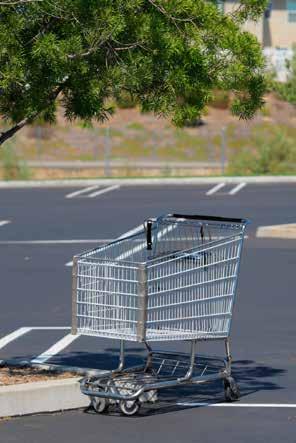


YOUR RETAIL SOLUTIONS YOUR RETAIL SOLUTIONS Full Suite of Services 2 www.retailsolutionshq.com SHOPPING CARTS CRV SERVICES COUPONS GOVERNMENT COMPLIANCE FOOD MARKETING
PRESIDENT’S MESSAGE
Connecting the Dots for Present and Future Leaders
RON FONG PRESIDENT AND CEO CALIFORNIA GROCERS ASSOCIATION
It’s been A first quarter chock-full of opportunities to engage as industry leaders
It’s the first issue of 2024, and we’re setting our sights on a topic that is always top of mind during the first quarter: leadership. It all starts in Hawaii, where CGA sets aside time in January to find new inspiration in partnership with the independent grocery community. The Independent Operators Symposium is full of fun, yes, but also fresh thinking and inspiration. In this issue we’re bringing a bit of that Aloha spirit to you by sharing a feature from Steve Black, who was one of the event’s most popular speakers.
Take it from me, Steve is fantastic, and the retail wisdom he draws from his experiences working at Lucky’s Farmers Markets, Rouses Markets, and Sprouts Farmers Market will help you show up better as a leader for your employees.
The opposite bookend to the Independent Operators Symposium is the CGA Educational Foundation Hall of Achievement event, which honors industry stalwarts for a lifetime of success in the grocery business. This year’s Hall of Achievement features two people, who couldn’t be more deserving, Denny Belcastro, Kimberly Clark Companies, and Karl Schroeder, Safeway Northern California Division.
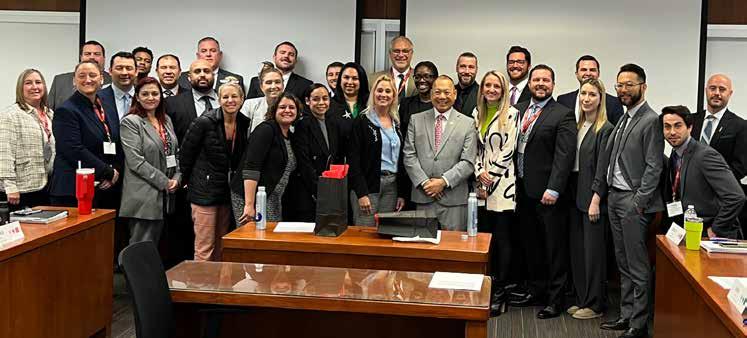
Outside of CGA’s events calendar, Q1 has also brought about a reinvigorated focus on leading in the California State Legislature. Having added Vice President, Government Relations, Daniel Conway to the team, the Association is off to a flying start.
CGA is currently leading conversations around food deserts, plastics, PAGA, and, of course, retail theft. It’s already been an action-packed year, and our contract lobbyist Louie Brown’s “Capitol Insider” column offers a great primer on the vibe currently inhabiting the Capitol.
As an industry, we always have to keep an eye out for the next generation. CGA Chair
to
If I can leave you with one final thought about leadership, it’s these words from Steve Jobs: “The dots only connect looking backwards.” In practice, this means trusting your gut and setting a vision that allows you to move forward. More often than not, you’ll find success. ■
Lynn Melillo and I visited the USC Food Management program earlier this year, which is consistently one of the year’s true treats. I know it’s my job
leave its students inspired, but I usually find myself equally inspired by the program’s students and up-and-coming grocery leaders.
CALIFORNIA GROCER | 5
Ron Fong, CGA Board Chair Lynn Melillo visit USC FIM students
CHAIR’S MESSAGE
LEADERSHIP THROUGH COMMUNITY
LYNN MELILLO BRISTOL FARMS
It has been a very busy few months since I became chair of the California Grocers Association.
Let me start by saying how proud I am to serve this Association in a leadership role. I do not take this position lightly and vow to do my best in representing retailers and suppliers in this industry that we all love.
In my first official duty as Chair last December, I testified in front of the Little Hoover Commission to share the grocery perspective on retail theft on behalf of CGA and its members. Tasked by the Legislature to conduct research and report back with a policy recommendation on retail theft, this was the second in a series of retail theft hearings to help the commission complete its report. This was quite the experience, and I encourage you to watch the segment online if you haven’t already.
Chair of the Commission Pedro Nava stated in one of the hearings that the witness testifying should consider it a compliment if you are interrupted with questions from commissioners. My testimony, which was slated to take 10 minutes tops, ran almost a full hour. Their interest was an indication of the greater momentum around finding a solution to retail theft in the Legislature and Capitol. While I was happy with the level of engagement from commissioners, I was also surprised by the tone of the questions and
their expectations. We learned that they are data-starved, and we as an industry need to do a better job in reporting all incidents to law enforcement and tracking the number of incidents occurring in our locations along with the dollar value of each incident.
To help tackle this need, CGA has created a Retail Theft Committee to gather data from members that we can share with the Legislature to demonstrate the severe impacts of retail theft. We’re hopeful that our efforts will lead to some change in legislation to positively help our industry. I look forward to working closely on this issue with CGA and members throughout the year.
In January, I took a break to attend the Independent Operators Symposium on the Big Island in Hawaii. This was such a special time to spend with members of the Association who represent independent stores and family businesses. It was a beautiful setting for the perfect dose of education mixed in with a whole lot of fun.
We had the pleasure of welcoming a warm friend and colleague to the industry for a special session, Leslie Sarasin from FMI. In her session, Leslie discussed state politics and the issues she and her team are battling
in Washington on behalf of the industry. We also heard from Steve Black on the “5 Rules” for Transforming your Culture for Yourself, Your Team and Your Family. This was my favorite educational session as it provided me with confirmation that you can and should be a kind and compassionate leader while still expecting successful results from your teams. Be sure to read Steve’s leadership piece later in this issue.
Steve brought wristbands for everyone to take back to their teams with the 5 Rules printed on them and I was excited to share them and what I learned during our weekly team meeting.
The wristband is a quick reminder for us to follow the rules:
Do Your Job, Be Kind, No Surprises, No Drama, and Protect The Brand.
As we celebrate industry leadership in this issue and consider what it means to be a leader in grocery, this is sage advice that we can all benefit from. ■
| CALIFORNIA GROCER 6

Find out more about our organic and conventional produce, plus our full floral program. connect


with fresh
Soul Food For Thought
KEVIN COUPE FOUNDER MORNINGNEWSBEAT.COM
Retailers must remain true to their core as they chase new advertising and data opportunities
I don’t quote the Bible very often. While I am a long-retired altar boy who can occasionally pull remnants of the Latin mass from the recesses of memory, these days I’m mostly afraid that if I use Scripture to support my positions on anything, I’m likely to get hit with a bolt of lightning.
But I’m going to risk it, because there is a specific passage from the Gospel, according to Matthew, that I’ve been thinking about lately:
For what will it profit a man if he gains the whole world but forfeits his soul?
(I think I remember the line because it was said to me numerous times by members of the clergy, especially Dominican nuns, right before they hit me with a metal ruler. But that’s a subject for a different day.)
The subject that brings this sentiment up, strangely enough, is alternative revenue sources.
Yeah, I know that sounds strange. But hear me out.
Over the past year or so, specifically since the end of the pandemic that created a stress test for so many retailers and suppliers, there has been a lot of conversation about developing these sources. Much of the talk has focused on retail media networks, which everybody and their brother and sister is trying to create. Some folks are doing them in-house, and some are using outside vendors.
The notion is that technology now makes it possible to develop media networks that can communicate in new ways with the shopper, influence their thinking, prompt additional spending, and drive new revenue to the bottom line. Baskets, the logic goes, will get bigger. Transaction sizes will get larger. And margins will grow as well.
However, the real “gold in them thar hills,” to borrow a turn of phrase from Mark Twain, is seen as advertising revenue. Ad dollars will be used to support the building and continued operation of these networks, and ad dollars will serve as significant new revenue streams to support retailers’ other activities as well as bolster profits.
All of which is fine. Everybody has the right to make a buck.
In fact, this approach is consistent with the food industry’s long tradition of using alternative revenue streams—slotting allowances, failure fees, promotional charges—to support the business. Retailers have been doing it for years.
My old friend Glen Terbeek, who launched a concept called Smart Store when he was with what then was called Andersen Consulting more than 30 years ago, used to talk about how if you added up all the promotional dollars provided to US food retailers, it was pretty close to being equal to the amount of industrywide annual profit. In other words, the allowances were the profit. And Glen would ask if the construct was one in which

VIEWPOINT
iStock | CALIFORNIA GROCER 8

stores were in fact distancing themselves from what customers wanted and needed by depending on this alternative revenue.
I’d ask a similar question today, though the context certainly is different.
Technology has made it possible for retailers to know far more about their shoppers than ever before. It is possible to analyze their shopping trips in a granular way, whether those trips are to bricks-and-mortar locations or online. Retailers can have a microscopic view of what people buy and, maybe even more importantly, what they don’t buy. They can see when they shop, how different shopping trips result in different purchases, and can target customers with surgical precision.
But do they? Will they?
What concerns me about these retail media networks is that the lure of fast cash will lead retailers to depend on ad dollars to the same degree that many have depended on their plethora of allowances available to them.
I worry that the ads will result in more noise, more clutter, that will annoy the shopper, not inform and persuade them. It would be nice if every message received via these
networks—whether online or in-store— reflected both the totality and the reality of that specific shopper’s experience with the retailer, but is that likely to happen? Likely not, methinks.
Not to pick on one company, but if there is a persistent recent criticism of a certain online user experience, it is that it has been diminished by the onslaught of “sponsored” products that come up when doing a search. This online retailer arguably has the best shopper data available, and a greater capacity for analysis than almost anyone, and yet if I go online to look for a widget by size, brand name and even color, I’m likely to see a number of sponsored alternatives before I get to the one I specifically asked for.
If I just search for a “widget,” then I’m fair game. But if I am specific about what I want, and have to run a gantlet of options before finding what I originally asked for, that, to my mind, is a problem. (Be honest. You know this has happened to you. As a consumer, you hate it. But as a retailer, would you be willing to do it in order to generate revenue?)
I believe passionately in the power of media, and I think that nuanced, selective retail media networks can be a powerful tool in
turning a retailer from being simply a source of product into an invaluable and essential resource. As in so many cases, this is a tool that if used correctly can be an effective arrow in a retailer’s quiver.
In the end, though, it has to be the retailer’s arrow and the retailer’s quiver. And the retailer has to either create or empower networks that put the customer experience first. If retailers make the customer experience a secondary consideration, then they run the risk of also being relegated to a secondary position as the shoppers make choices about where to spend their money. In a consolidating marketplace filled with competition, being secondary may not be enough. You can fall to being tertiary. And then irrelevant.
Job one: Retailers have to preserve their own souls—the core values of their brands, the elements that make them different and the unique connections that they should be developing with shoppers.
Can I get an Amen? ■
VIEWPOINT
CALIFORNIA GROCER | 9
iStock
INSIDE THE BELTWAY
Food Industry Committed to Health and Well-Being Initiatives
JENNIFER HATCHER
CHIEF PUBLIC POLICY OFFICER & SENIOR VICE PRESIDENT, FOOD MARKETING INSTITUTE
FMI report finds most food industry companies implement established nutrition, health and well-being strategies
As Americans’ interest in nutrition and healthy eating has increased in recent years, companies across the food industry have implemented numerous initiatives to support consumers’ health needs and priorities, according to FMI – The Food Industry Association’s new Food Industry Contributions to Health and Well-Being 2024 report
The grocery store has become an increasingly important and accessible destination for health and well-being in the community—providing everything from feeding assistance to preventative care to nutrition guidance, all while helping consumers shop for and prepare nourishing, practical meal solutions for themselves and their families.
The industry is continuously working to meet consumer demand for nutrition and health and well-being services in order to positively impact food purchasing decisions both online and in-store. These range from personalizing nutrition recommendations to spotlighting product claims as well as working to support and nurture healthy shopping, cooking, and eating habits.
In fact, FMI’s report finds that 70% of responding companies are currently operating with established nutrition and health and well-being strategies for both customers and their own employees. That percentage is even higher, at 84%, if we look just at food retailers.
Registered Dietitian Nutritionists (RDNs) increasingly play an important role in developing these strategies and have a seat at the leadership table. 71% of responding companies have dietitians in place at the corporate level, where they integrate with company executives to drive strategic leadership, regulatory affairs, labeling, ecommerce and digital merchandising, and marketing and communications initiatives. Nearly one in five companies surveyed employ registered dietitians in their retail locations in a variety of roles impacting the health of both customers and employees.
Nutrition teams are also becoming more diverse, incorporating a wider cross-section of an organization’s overall leadership framework. The individuals who are responsible for driving health and well-being opportunities include nutrition leadership, such as RDNs, and health and well-being leadership. Other leaders in the C-suite, human resources, and pharmacy teams are all increasingly involved in shaping health and well-being opportunities across responding food industry companies.
With more consumer interest in connecting the science of food and nutrition to overall health, the opportunity to implement Food as Medicine programs, particularly in the grocery store setting, is growing in importance. FMI has resources in this area to help companies navigate the developments and opportunities in the Food as Medicine space. These include a report we published in partnership with Oliver Wyman titled “How Accepting Healthy Benefits Support Customer Wellbeing,” as well as a related digital seminar exploring the topic in greater detail.
| CALIFORNIA GROCER 10
With increased awareness and interest, companies are delivering highly relevant strategies and programs, designed to help reduce diet-related disease and support health goals for shoppers. Most prevalent are path-to-purchase marketing, incentive programs and personalized nutrition education solutions that work together with prescription programs and medically tailored nutrition. Food industry companies are also making nutrition and health programs tangible for employees, with companies increasingly offering nutrition counseling and well-being and weightmanagement classes.
In addition to providing signage, displays, nutrition attribute labeling, recipe ideas, and lifestyle guidance, RDNs in the food
industry are also providing group classes and one-on-one nutrition counseling, also referred to as medical nutrition therapy (MNT), directly to consumers both inperson and virtually. The positive health outcomes of MNT have been repeatedly studied and documented and prove again that the grocery store is an accessible destination for health and well-being.
As consumers increasingly seek support to achieve their health goals, food industry companies will continue to work to align their health and well-being strategies with overall company strategy, mission, and vision through the work of registered dietitians and other health professionals to improve the nutrition and health of customers, employees, and communities. ■

To download the Food Industry Contributions to Health and Well-Being 2024 report, visit www.FMI.org/HealthandWell-being.

INSIDE THE BELTWAY iStock CALIFORNIA GROCER | 11
WASHINGTON REPORT
Election Year Advocacy
GREG FERRARA PRESIDENT AND CEO NATIONAL GROCERS ASSOCIATION
The past year of advocacy has been busy for independent grocers, and there’s more in store for 2024
With an election on the horizon in which the White House and control of Congress are on the line, 2024 is shaping up to be an interesting year.
Pending legislation and regulatory changes in the coming year are sure to influence business operations, supply chain management, and consumer expectations— and indeed, they’re influencing NGA’s advocacy efforts as well.
To be sure, the past year has been busy for NGA in support of independent grocers. Breaking it down by the numbers reveals a flurry of activity that has helped make significant inroads toward our policy goals: nearly 200 meetings between independent grocers and policymakers during last spring’s Fly-In for Fair Competition in Washington, D.C.; 35 advocacy meetings convened during last fall’s Executive Conference and Public Policy Summit; at least 20 action alerts sent this past year, calling members to action on matters of policy; nearly two dozen store tours that hosted elected officials to illustrate the impact of policy on their local communities; and more than 2,000 grassroots messages sent to Capitol Hill, including personal outreach from NGA members to their
members of Congress during a push to support the Credit Card Competition Act, a bipartisan effort that would bring crippling swipe fees under control.
Additionally, NGA launched Grocery Guard, a “grasstops” initiative creating a nationwide network of owners and industry leaders who have volunteered to contact a member of Congress when independent grocers need to relay the importance of a particular issue impacting the industry. Efforts by NGA and our members helped to secure an extension of the EBT processing fee prohibition in the Farm Bill extension.
These wins are adding momentum to independent grocers’ policy priorities for 2024.
Antitrust reform remains at the top of the list. NGA seeks revived enforcement of the Robinson-Patman Act (RPA), which levels the playing field for smaller retailers by prohibiting dominant retail buyers from using their muscle to secure more favorable terms on goods than competitors.
Progress has included congressional pressure on the FTC to enforce RPA; enactment of federal law allowing State Attorneys General to more strictly enforce antitrust laws; advancement of NGAdrafted legislation that would give the Small Business Administration power to address anticompetitive conduct; and enhanced public awareness through the media. There’s still plenty more to do, including more congressional hearings and introduction of RPA reform legislation.
Support for credit card reform is growing due to our grassroots strength, our cultivated champions in Congress, and the powerful message of independent grocers who serve at the heart of their communities. Requiring the 30 largest issuers of credit cards to enable dual routing would create more competition for an expense that is particularly burdensome for smaller retailers.
iStock | CALIFORNIA GROCER 12
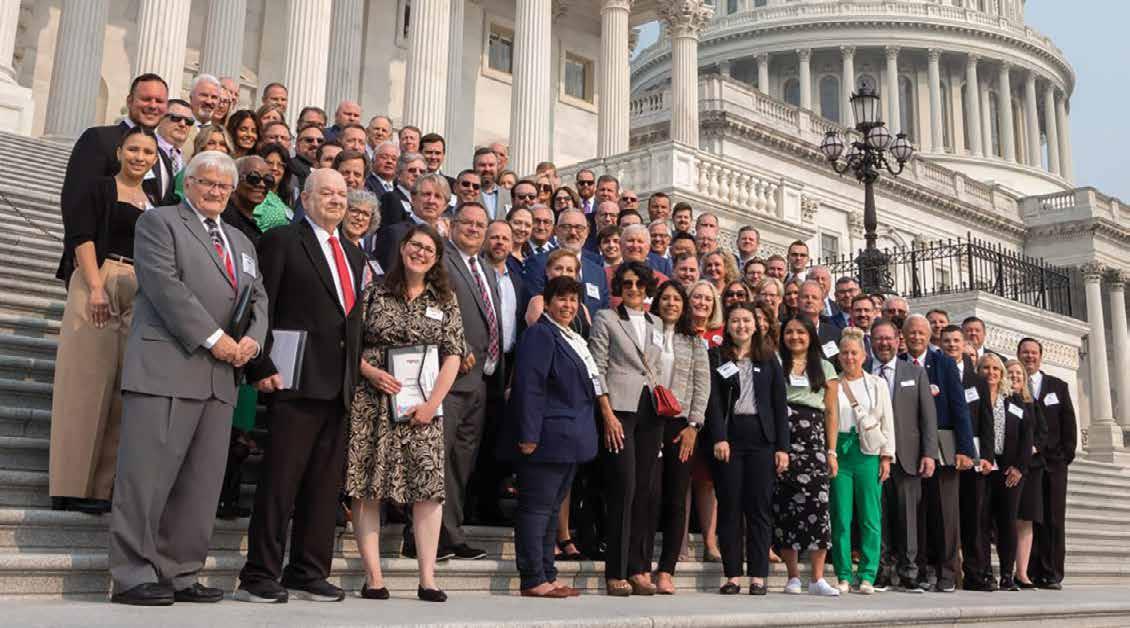
The current Farm Bill expired on Sept. 30, 2023, and the recent one-year extension comes as Congress works toward a new five-year plan. NGA will continue its work to advance a comprehensive bill that includes a permanent ban on EBT processing fees, maintaining SNAP Choice to allow participants to choose the right foods for their family; stopping the SNAP Nutrition Security Act to protect consumer and retailer data from burdensome reporting that could lead to SNAP restrictions; and expanding nutrition incentives by streamlining access to produce.
Meanwhile, numerous regulatory developments in play revolve around labor and workforce, including the OSHA walkaround rule, overtime rule changes, a return to the “ambush” election rule, and the NLRB Joint-Employer Standard. To limit their impact on independent grocers, NGA has filed comments with the relevant agencies and participated in public hearings,
lobbied Congress to roll back potentially harmful rules, and joined alliances with other organizations such as the Coalition for a Democratic Workplace.
Additional regulatory activity is aimed at other aspects of business operations, such as the refrigeration HFC phasedown. The AIM Act, signed in twilight of the Trump presidency, implements an international treaty that phases out HFCs due to their ozone-depleting properties that will require supermarkets to re-equip their refrigeration systems, estimated to cost around $1.5 million per store. NGA has allied with FMI, NRF, and RILA to advocate for minimizing the impact on retailers. Additionally, a new FDA traceability rule under the Food Safety and Modernization Act (FMSA) requires grocers and wholesalers to maintain a traceability plan that requires grocers to provide traceability information with 24 hours’ notice. NGA has filed comments with the FDA and is trying to
obtain an extension of the Jan. 1, 2026, compliance deadline, and has entered into solution partnerships.
It’s truly a historic time for independent grocer advocacy. In what is essentially a three-front battle for the future of the industry, there’s real opportunity to level the playing field for the first time since RPA’s passage in 1936; a good chance to lower swipe fees and bringing competition to the credit card marketplace; and the opportunity to strengthen federal nutrition programs that bolster independent grocers’ efforts to feed communities across the country.
These priorities will guide our engagement with policymakers when we reconvene May 21–22 for the next Fly-In for Fair Competition—we hope you’ll consider joining us. ■
To learn more about this report and additional industry resources, visit www.nationalgrocers.org/resource-center/.
WASHINGTON REPORT CALIFORNIA GROCER | 13

Serving Up the Freshest Eggs for Generations.
NuCal Foods

Family Farms Producing California’s Freshest Eggs.
Our local California Family Farms have been providing farm fresh eggs daily to your stores. In addition to producing fresh, nutritious, high-quality eggs, we take pride in the traditions and values of being good stewards of the land, providing superior care for our hens and giving back to the communities that support us.


Riding California’s State Budget Roller Coaster CAPITOL INSIDER
California’s State Budget process budget process has been one of the scariest roller coaster rides in the nation!
While the recent surplus was spurred by billions in COVID recovery money from the federal Treasury, our budget has been on a boom or bust cycle for quite some time. This is one of the main reasons why Governor Jerry Brown pushed so hard to get voters to adopt a Rainy-Day Fund, where the Legislature sets aside funds in good years to soften the blow in bad years. This year, the fund will most likely contribute about $13 billion to the state budget, leaving about the same amount remaining in the fund to help with future deficits.
While there is no disagreement that we are facing a deficit, there is a significant disagreement on how big the hole really is. In late December, the Legislative Analyst’s Office (LAO) issued its analysis of actual and projected tax returns and stated the budget deficit would be an estimated $68 billion. Two weeks later, the Governor released his budget for the next fiscal year claiming the budget was only $38 billion. Now, it’s not uncommon for there to be a difference between the Governor’s Department of Finance and the LAO, but a $30 billion difference is quite unheard of. The LAO attempted to explain the Governor’s lower estimate by stating he and the Department of Finance were using a different baseline to calculate education spending. As a former Chair of the Budget Committee
said recently, “When the Governor and LAO differ on deficits, more times than not the LAO is right.”
The solutions proposed by the Governor’s budget include deferral of certain spending to outyears, transferring what would otherwise be General Fund spending to special funds, and loans from other special funds. One loan in particular that should raise concerns among the grocery industry is the $125 million to be borrowed from the Beverage Recycling Container Fund (BCRF), which is in addition to the $140 million loaned from the BCRF last year.
The BCRF is funded by deposits made by consumers for each eligible beverage container they purchase. In other words, the money in the BCRF was made possible by those consumers that purchased beverages but have chosen not to redeem. These funds support a variety of programs and policies that sustain California’s bottle bill program, including handling fees paid to convenience zone recyclers to help them stay in business. When the state borrows from the BCRF to the point when it cannot meet its statutory requirements, all programs face a “proportional reduction” in funding, which increases costs to those paying into the program, like beverage manufacturers, and cuts the amount of money available for those who rely on it to remain in business, like recyclers.
While the Governor’s proposal states the money to be borrowed from the BCRF is “not currently projected to be used for operational or programmatic purposes” and the loan “will not result in proportional reductions,” there is no evidence provided to support the claim. In fact, we have witnessed the exact opposite in the past when other governors loaned from the BCRF. Between 2002 and 2009, more than $519 million was borrowed from the BCRF to support other General Fund programs. In April 2009, the administration testified that the BCRF was solvent and the loans would create no jeopardy. Within two months of their testimony, the BCRF was facing a significant deficit, and by November proportional reductions were triggered. There is reason to fear the same could happen this year. With the recent expansion of the bottle bill to include wine and spirits, there’s a possibility a large number of containers could be redeemed that never paid into the program. In addition, the grocery industry is actively working towards the 2025 requirement for a Dealer Cooperative, which will likely need assistance from the fund to become operational. The possibility of proportionate reduction this year could result in far more pain than we have witnessed in the past.
CGA is combining efforts with fellow stakeholders in the bottle bill program to ask the Legislature to reject the Governor’s loan proposal on behalf of the grocery industry. ■
Brown LOUIE BROWN
IN THE SACRAMENTO OFFICE OF KAHN, SOARES AND CONWAY, LLP
CALIFORNIA GROCER | 15

EXPLORING MERGERS, ACQUISITIONS, AND THE FUTURE OF GROCERY
By Michele Fuller
Grocers are no strangers to navigating uncertain times. From the quaint corner stores to the retail giants, their journey has been one of constant adaptation to consumer behavior shifts, rising food prices, inflation, and economic recessions. The pandemic, however, revealed new resilience in the industry as grocers had to swiftly implement safety measures, address supply chain disruptions, and bolster e-commerce for contactless shopping. In many ways, the industry emerged stronger than ever before.
Yet, since the pandemic and subsequent food inflation have cooled, grocers face a new challenge as a rapid increase in corporate restructuring, strategic consolidation, and mergers and acquisitions create a new dynamic in the ever-changing market.
STATE OF THE INDUSTRY:
THE POWER SHIFT: EXAMINING MERGERS AND ACQUISITIONS
In 2023, amidst nearly a dozen significant grocery mergers, the $24.6 billion Kroger-Albertsons deal, with related divestitures to C&S Wholesale Grocers, holds the spotlight as the largest proposed grocer merger in history. The approval of the merger is not merely a business transaction; it has the potential to reshape the lives of consumers, workers, and the industry as a whole.
“A general talking point when they announce these mergers is that they’re going to be stronger and have better supply chains, which will ultimately trickle down to the consumer who will benefit from a better product at a cheaper cost,” shares Brent Haapanen, who leads the M&A practice at DCA Partners, advising transactions in and around the grocery space, including branded products, distribution, food manufacturing, and store-level acquisitions.
“The alternative viewpoint,” he says, “is that consolidation means fewer options for consumers. Therefore, that retailer in that particular region will have a pretty significant power over the consumer.”
The possible impact is colossal, with KrogerAlbertsons poised to make up 16.6% of the market share, second behind Walmart at 23.3%. Pending the decision on the merger, Kroger-Albertsons would own
5,000 stores nationwide, 800 in California alone, even after accounting for the 66 stores being divested to C&S.
By leveraging the unique strengths of both Kroger and Albertsons independently, their collaboration holds the potential to level the playing field with industry leaders. However, amidst the ongoing innovations introduced by retail giants such as Walmart and Target—ranging from the expansion of fresh and organic groceries to improved automated services and consistent upgrades in both in-store and online shopping experiences—the market gap persists and widens. Achieving the buying power, e-commerce capabilities, delivery options, and general merchandise offerings of these retail giants will be a considerable undertaking for Kroger-Albertsons.
As for the smaller regional grocers, the approval of the Kroger-Albertsons deal could influence a cascade of strategic consolidations and mergers to stay competitive in the evolving market. “I think we’re going to see some additional consolidation in the mediumsized space again,” Haapanen predicts, “as the other more regional players try to come up with ways to compete against these larger folks who are coming into the market or who are consolidating and have better pricing power over the staples that everyone’s offering.”
“A general talking point when they announce these mergers is that they’re going to be stronger and have better supply chains, which will ultimately trickle down to the consumer who will benefit from a better product at a cheaper cost.”
Continued on page 18 ▶
2024
CALIFORNIA GROCER | 17
◀ Continued from page 17
M&A STRATEGIES: A MULTIFACETED APPROACH
Beyond traditional M&A, grocers are exploring alternative acquisitions that enhance growth and diversify revenue streams through in-house opportunities. Haapanen classifies M&A in the grocery space into two categories. “There’s the store footprint consolidation/acquisition/expansion strategy around buying footprints, buying locations, or buying access to new regions. And then there’s the other side of it, which is: what are the value-added components of that grocery or retail offering, and how can they augment that offering through M&A?”
Grocers reluctant to formally merge horizontally may find value through greater vertical integration or partnerships with new suppliers, brands, consumer data, and e-commerce companies. Organizations often use vertical mergers and acquisitions to close a gap where they may be underperforming or losing potential profit.
For example, in 2022, Walmart acquired Alert Innovations, an automation firm specializing in material-handling technology, to utilize its store footprint for order fulfillment and reach customers quicker. According to CFO John David Rainey, in 2023, Walmart’s e-commerce losses were lowered by 40%. Rainey contributed this to their increased in-house fulfillment.
Walmart’s acquisition also allowed them to maintain complete control of the order fulfillment process, thus more influence over consumer satisfaction. Haapanen suggests, “From a delivery and distribution standpoint, it’s the question of whether you want to own that user experience or outsource that user experience because it’s often still associated with your brand. If I’m using Instacart to order from Safeway and a bunch of my items are out of stock…I don’t necessarily blame Instacart.”
“Organizations often use vertical mergers and acquisitions to close a gap where they may be underperforming or losing potential profit.”
CONSUMER VALUE AND BASKET SHARE
One challenge for regional and independent grocers is managing customer demands for lower prices while catering to their interest in high-quality, specialized items. Mid-sized grocers, in particular, may be unable to offer the most competitive prices. Instead, they might focus on delivering greater consumer value and expanded offerings through mergers, acquisitions, partnerships, or organic initiatives.
Grocers can differentiate themselves from competitors by enhancing in-store experiences, private labels, loyalty programs, brand partnerships, e-commerce, and prepared food. Haapanen emphasizes, “The local and regional players are carving out more basket share by adding unique offerings. They’re providing discovery for more local products. They are doubling down on a particular niche with respect to ‘better for you’ options.”
“People are coming to the regional players for their high-end, high-quality, unique, or niche items,” he adds, “But they’re still shopping around; they’re still going to major national players to fill 65–70% of their overall basket. So trying to capture more of that basket at the regional level is important.”
Some analysts project price deflation for food items in the near term, which adds additional complexity as grocers navigate the balance between consumer satisfaction and profit. An expert in grocery retail, consumer, and supply chain challenges and trends, Erickson points out, “Grocery product prices have increased due to inflation, pushing customers to opt to save money and spend less on unnecessary products. The pricing deflation prospect moving into 2024 could place pressure on operator margins during a time when labor costs are already high.”
| CALIFORNIA GROCER 18
THE FUTURE OF TECHNOLOGY
The pandemic prompted grocers to accelerate the adoption of technology for online shopping. With the rise of AI, subscription services, and the influx of consumer data, grocers can expand their digital offerings, reach more customers, and streamline their services.
“Grocers had to invest in their technological infrastructure significantly,” Haapanen says, “I think there will be some technology-driven M&A activity as grocers look to gain better insights and more complete customer profiles by leveraging the vast wealth of consumer data they currently have, with the goal of creating a more personalized shopping experience.”
Some of the major players are setting the precedent with digital innovation. Stacey Erickson, whose company, Clarkston Consulting, helps retail and life sciences clients with strategic, management, operations, and technology implementation challenges, notes, “There’s increasing competition with big brands such as Walmart, Costco, Aldi, and Amazon. Subscription services with added convenience, such as Walmart+, will continue to be big game-changers for
customers looking for an “easy” way to get their groceries. Industry unit volumes are down 3%, but major players like Walmart are up 1% individually.”
Retail giants may dominate hybrid and digital shopping through powerful collaborations. However, regional grocers can still utilize these tools to deepen consumer engagement and increase e-commerce. “Ultimately, the ones that outperform and survive will be the ones that can really leverage that omnichannel approach,” Haapanen says.
The potential to save time and money through digital innovation is profound, but determining where and how to invest can be complex. It’s essential to consider the risks, including data security, technological challenges, supply chain vulnerabilities, and regulatory compliance. Proactive measures, such as robust cybersecurity, transparent policies, and comprehensive training, are crucial for successful integration.
For grocers, strategies around technology may be a series of trial and error. Yet, they offer new and exciting opportunities to reach more customers and strengthen their existing unique offerings.
“The increased buying power of Kroger-Albertsons intensifies the strain on suppliers more broadly, as they may face pressure to settle for lower prices.”
IMPACT ON SUPPLIERS: C&S WHOLESALE GROCERS’ STRATEGIC MOVE
C&S Wholesale Grocers’ acquisition of 413 stores from KrogerAlbertsons, including 66 in California, prompts considerations about its competitiveness and potential repercussions on the supply chain.
Erickson underscores C&S as “a leading retailer and wholesaler that creates a shopping experience more direct to the customer.” She adds, “This deal will create a mega-competitor that might cause an uptick in other M&A deals and also have an impact on business real estate.”
While it’s early to determine if more wholesale and supplier brands will explore vertical integration into the retail market,
Erickson anticipates, “The consolidation could spur other brands to follow suit to combat falling revenue in the grocery space, putting more pressure on regional players.”
The increased buying power of Kroger-Albertsons intensifies the strain on suppliers more broadly, as they may face pressure to settle for lower prices. This uncertainty also extends to smaller suppliers, who may, in turn, have to consider price hikes for the regional and mid-sized brands to maintain their spot on the Kroger-Albertsons shelves. This ripple effect widens the pricing gap between large and regional players, which could severely affect smaller entities’ profit margins.
Continued on page 20 ▶ CALIFORNIA GROCER | 19
LABOR DYNAMICS: CA MINIMUM WAGE INCREASE IMPLICATIONS
California’s move to raise the minimum wage for fast-food workers to $20 an hour starting on April 1, 2024 presents an interesting landscape for the restaurant and grocery industries.
The rise in labor costs for fast-food operations will likely increase fast-food prices, prompting consumers to spend more time cooking at home, as a cost-effective alternative, translating to increased spending at the grocery store.
While the potential of increased sales offers an exciting opportunity for grocers, this shift in consumer behavior also shines a spotlight on possible operational and workforce challenges. The surge in demand will require grocers to have a well-managed workforce, ensuring adequate staffing levels, wage structures, and overall employee satisfaction.
But employment and retention poses a challenge in California. Erickson explains, “California is experiencing very low job growth—its workforce decreased after the pandemic, and few jobs are being created, establishing a stale job market.
The market is predicted to slightly increase in 2024, but it will need to correspond with a stimulated economy to minimize layoffs and difficulty hiring for a limited number of positions.”
The attractiveness of the fast-food market for workers could intensify competition for the limited number of available employees, leading grocers to consider raising pay and offering additional benefits to retain their staff.
“There’s a larger industry push for higher wages,” Erickson says, “which is consequently pushing companies to find ways to decrease other operational costs and boost productivity. The rise of AI technology and automation in the supply chain could lead to companies cutting down on personnel costs.”
Haapanen adds, “Operating costs as a whole have seen an increase. Cost reduction for back office shared services can be critical. If you get any of those synergies related to back office operating expenses at the M&A level, there’s probably some benefit there.”
“There’s a larger industry push for higher wages,” Erickson says, “which is consequently pushing companies to find ways to decrease other operational costs and boost productivity.”
KELLOGG’S BOLD MOVE: A SPLIT FOR GROWTH
Amidst the wave of mergers and acquisitions, the grocery and food industry witnessed another significant move when Kellogg officially split its operations into WK Kellogg Co. for cereals and Kellanova for snacks. This strategic decision, akin to the industry trend of mergers and acquisitions, aims to encourage higher levels of growth in each category.
Erickson comments, “This split leaves more room for product innovation and focused branding,” Erickson comments. “Each half of the company will be able to focus on developing new and better products within their respective spheres, which might increase consumer access and sales of their products.”
Officially executed in October 2023, the split triggered notable reactions in the stock market, establishing a pulse for how these unique strategies may influence the larger economy. “Stock investments for both companies saw a slight slump at the beginning when the split officially happened in October 2023,” Erickson shares. “These initial slumps reflect the uncertainties surrounding such strategic decisions, as investors adjust to the
new corporate structure and anticipate the long-term implications for both entities.”
Kellogg’s decision is not isolated in the food and beverage sector. Historically, industry giants such as Kraft Heinz, General Mills, ConAgra Brands, and Sara Lee Corporation have taken similar initiatives, opting for brand splits or divestitures to optimize their operations and align with evolving consumer preferences.
As Kellogg joins the ranks of companies realigning their structures to adapt to industry shifts, the impacts of this strategic decision on long-term performance remains to be seen.
The grocery industry stands at a critical juncture where partnerships and M&A activities are central to growth, scalability, and resilience. Success hinges on continuous innovation, adapting to evolving changes, and prioritizing consumer preferences. Reflecting on the dynamic landscape, Haapanen concludes, “It’s been an interesting few years. So, I imagine there’s hope but also acknowledgment that it’ll be another year of hard work.” ■
◀ Continued from page 19
| CALIFORNIA GROCER 20

Cart Retrieval
Government ordinance compliance.
Cart Repair
Maintenance and repair on site.
Cart Sales
New custom cart sales with your branding.

Cart Leasing Extra carts during the holiday peaks. info@retailms.net

CART PROBLEMS? W E HAVE THE SOLUTIONS.
818.817.6712 www.retailsolutionshq.com For More Information info@retailms.net
FOR LEADING CULTURE TRANSFORMATION 5 RULES THE
By Steve Black, Founder & CEO, Abrighterday.life, COO, PFSbrands
Wouldn’t it be great if you could lock in on some simple life rules for success that you and your circle could easily understand and follow? Even better if everyone knew that those were the same rules you follow? AND—what if those rules could actually be applied in your home?
| CALIFORNIA GROCER 22
Editor’s Note: “In January of this year, Mr. Steve Black shared his book with CGA’s Independent Operators Symposium attendees in Hawaii and the response from the group was outstanding.
We asked Steve to share—in a condensed version—The 5 Rules, and he’s done just that below. We hope you’ll enjoy the lessons and embrace the possibility of launching these rules in your organization.”
RULE #1: DO YOUR JOB

This rule is so simple that everyone thinks they understand it without explanation. But sometimes, it takes an actual event to refer back to this key to truly understand it. The really cool part about this is that you can emphasize any one of the three words and it takes on a whole new meaning. DO your job, do YOUR job or do your JOB. I think the “do YOUR job” is the most used variation of the key.

In our retail stores, we are a “for profit” business and since we pay people to do their jobs, we simply ask they hold up their end of the agreement. We also challenge our team members to be IMPACT players. Those are players that change the outcome of the game. Not once, but every time. When you’re an impact player—you make the whole team better.
That is what Magic Johnson learned early in his basketball career. He was so successful as an individual player, but quickly realized that his job was to actually make the whole team better. And he did. Every game. Every season. Every level he played at.
On the home front, I need to do my job there as well. I often joke that it’s my job to pay the mortgage and take out the trash! But seriously, it’s my job to HAVE a job, to make sure my family is taken care of and feels secure. When our children were growing up, it was also my job to coach, train, and encourage them to be productive adults. It’s my job at home to be the same kind of leader there as I am at work. Obviously not exactly the same way, but to make sure the outcome is the same. And that’s simply to help everyone feels safe and secure. It’s imperative that I have a consistent mood, and am happy, present, and fun to be around.
RULE #2: BE KIND
Being kind or nice doesn’t mean being a pushover. It doesn’t mean that you don’t hold people accountable to do their job. It means you don’t demean people with your tone, word choices, or actions.
Be kind to everyone, even if they can’t do anything for you. One of my favorite sayings is:
“I can tell you everything I need to know about you, by the way they treat the person that can do nothing for you.”
It’s easy to be nice to your boss, the principal or superintendent, the president of the bank, and your best friend. Not so much for the slow drivers, incompetent cashiers or waitresses, or the fellow coworker or student that is difficult to work with or be around.
Being kind isn’t always easy. But it’s always right.
Clearly one of my greatest challenges. Not all the time, but certainly some of the time. We also can’t allow being busy to be an excuse for not being kind. Ever notice people trying to leave on vacation seem to be a little on the cranky side?
Continued on page 24 ▶
CALIFORNIA GROCER | 23

You’re never too busy to be kind.
And remember as a boss, don’t expect a pass card on this for those closest to you. You’re their boss. Be kind.
Over my career, I’ve had to determine to let some people go, not because they were incompetent in their job, but because they simply couldn’t be kind. Not kind to our customers and not kind to our other team members. (Trust me on this one, the team members on the receiving end of a corporate bully will thank you for purging the bully from the team. They might even enjoy watching it happen). I remind my teams often that all our paychecks come out of the same bank account, and we have the same logo on our shirts and should act like we are on the same team. And we certainly should never shoot our own wounded. Kind sometimes means that struggling team members just need a little extra grace.
Being kind at home after the end of a long hard workday is also a challenge. That’s our safe haven and if we’re not careful, our family takes the brunt of our “bad day.” I’ll cover that a little more under rule #4.
RULE #3: NO SURPRISES
This is by far my most quoted key from my team. It’s not unusual to see this on the subject line of an email or the opening line when someone walks in my office.
Put another way, this would just be communicate, communicate, communicate, communicate. In every area of our lives, we could all get along better, solve problems quicker, and make progress faster if we’d just make sure that the people that can actually help, know that there is a problem.

It’s also important to not over communicate. Sometimes, less is more. Learn the art of letting people know what they need to know and don’t weigh them down with unnecessary information. When the milk is running off the table, nobody needs a speech, they just need a towel.
I can’t tell you how many times over my career we had a raging fire that had to be put out immediately. If someone would have just come to me quicker, it would have never gotten to that point. We need to learn more about fire prevention, and less about firefighting.
RULE #4: NO DRAMA
This rule is always a crowd favorite because everyone can identify. It’s important that you fully understand what drama is and what it is not.
First—drama is not a family member dealing with illness or the inability to pay your electric bill. Those are life’s realities. We should all be concerned about situations like these and help as much as possible to get people through those valleys.
Second—drama is unnecessary fear and anguish, brought on by exaggerated facts or feelings and continually talking about it. To the point that you’re driving those around you nuts.
Here is the image you need to have when you pull in or out of your garage each day or walk in your home:
There is a DRAMA Towel hanging on the wall. It’s the towel you wipe your hands on when you come home and when you leave your home for work the next day.
Walk up to your Drama Towel when you arrive home for the day and wipe all your work drama on that towel, and enter your home fully dedicated to the people that are there and be fully engaged in your role. Be present. Fully present. Trust me, your three-year-old could care less about your job pressures. They just want you to color with them or watch Frozen II for the billionth time.

As you leave for work/school the next morning, stop and wipe all your home drama on the Drama Towel and enter your work/school place fully engaged and present. Then simply apply rule #1. Do your job.
The biggest reason you shouldn’t bring your work/school drama home? Your spouse, parents or significant other will want to fix it. They can’t. So leave it at work or school. For sure, you should bring home the exciting details and accomplishments of your job or accomplishments in the classroom and share those. Just not the drama.
◀ Continued from page 23
| CALIFORNIA GROCER 24
Everyone gets asked two questions at the end of the day. Whether it’s a call on the way home or an email or text. Question one is usually: “What’s for dinner?” Question two is usually, “How was your day?”
I always challenge my leadership team to give your people something positive to say when asked about their day. In fact, you should determine at breakfast that you’ll intentionally make the rounds and make sure that your team knows that you appreciate the hard work they’ve done or are doing. Let them know how important they are to the success of the company. Good leaders ask great questions, so take the time to engage them in the ‘how’ of what you do and let them be a part of improving your workplace.

RULE #5: PROTECT THE BRAND
Formerly this was called, “Protect the Mother Ship”. It’s important that all stores understand that if they don’t follow the proper safe handling laws, OSHA laws, and employment laws, they risk taking the mother ship down.
My new take on this after going public with my former company, is in all you do, whether at work, home, shopping, at a restaurant, sporting or social event—you represent the brand. Everything you say, everything you do is now at risk of tarnishing the brand. The brand isn’t the logo or the building that the business is in. It’s the thousands of people that work for the company.
My favorite object lesson of protecting the brand comes from a red serving plate. In 2002, we had a house fire and lost everything we owned. We emerged from that event with about five boxes of charred, smoke damaged items that we just couldn’t throw away. One of those items was a red plate that was a gift from our Aunt Fanny. It had been in an antique oak cabinet that had also been in the family for four generations. This plate, smoke damaged and all, did survive the fire. Every time we see it today, we are reminded of how special that gift was and that it was able to survive a fire that destroyed our home and all of its contents. In a way, it represents the heart of our family.

In that same way, this plate could also stand for the heart of a company, the heart of the brand. Just like that cabinet surrounded and protected that plate, we should all surround and protect our team, our owners and our families. At the water cooler, in the break room, in our work cubes, as we travel, at the office and in our homes.
Protect the brand in everything we say, the way we act and everything we do.
Good choices = Good consequences
Bad choices = Bad consequences
I want to challenge you to live these 5 simple rules in every area of your life. It’s then that you’ll gain the respect of your peers. And at the end of the day, that’s really what all of us want, to be respected. ■

The book is available anywhere you buy books or on his website at www.abrighterday.life
CALIFORNIA GROCER | 25
of California’s Grocery Community
FROM A SUSTAINABILITY SPECIALIST TO AN E-COMMERCE EXPERT TO A FAMILY GROCER, THIS YEAR’S RISING STARS LIST HIGHLIGHTS SOME OF THE BEST AND BRIGHTEST TALENT IN THE INDUSTRY.
| CALIFORNIA GROCER 26

SAM HARRIS
Government & Public Affairs Manager, UNFI
How did you come to work in the grocery industry?
I grew up in rural Arkansas—where many grow their own food and many more live day-to-day without much of it. I think this is where the windy path to the grocery industry started for me.
My dad was a high-school agriculture education teacher, and throughout school
I was a member of the National FFA Organization (formerly Future Farmers of America). I grew up learning the importance of farming and knowing where your food comes from and the work it takes to grow it. Early on, the challenges facing Rural America were made clear to me and I quickly learned the outsized role that food security plays in holding back the potential of so many in our country. This sparked an interest in me while contemplating where I wanted my college career to take me. I loved public service and felt compelled to use my expertise and passions to do more
for communities like the one I grew up in. So, I attended the University of Arkansas where I studied Agriculture Business Management and Agricultural Leadership & Communications. Throughout undergrad, my focus began to center around economic development and the role food production plays in it. From there, I went on to study international economic development at the University of Cambridge, once again centering my studies around agriculture and food systems.
After graduate school, I had an itch for getting to Washington, DC to use what I had learned and the experiences I had to shape food policy on a larger scale. From working on various political campaigns to later advising a U.S. Congressman from the Central Coast of California on agriculture and food policy, I found a career track that allowed me to have the best of both worlds— supporting Rural America and feeding people in the process.
After my time on Capitol Hill, I had an opportunity to join UNFI to help establish its first dedicated government and public affairs team. Once again, bringing my interests in food policy to a place ripe with opportunity to serve our customers, feed people, and build a better food system for all. While the path to where I am today with UNFI wasn’t always clear, looking back, it all makes sense!
What’s your current role?
Government & Public Affairs Manager at UNFI
What unique perspective do you think you bring to your work in the industry?
I think having worked in the legislative branch and on political campaigns I bring
an understanding of how integral the food industry is to the strength of our country and economy. Getting to know constituents and speaking with voters for a living gives you a front-row seat to what really matters to people and ultimately what’s on our customers’ minds. As we all know, your local grocery store is often a lot more than just a place you go to get food.
What’s your favorite thing about being a grocer/supplier?
The coolest part of my job is that I know each day what I do impacts people in every state. When you look back to the height of the COVID-19 pandemic, it was grocers and the food-supply chain that everyone relied on to carry on (and we did a really great job!). I also get to learn something new every day because the grocery industry is rapidly changing.
What inspires you?
When someone or something is focused on simply making things better. Take a look at our industry—grocers stock shelves all night and open stores at the crack of dawn because their job is to feed people and sustain communities. Walk into a warehouse where hundreds of employees are working around the clock—24/7, 365 to ensure product gets delivered on-time and meets our customers’ standards.
To me, inspiration looks like the challenges our industry takes on every day from electrifying our fleets to combat climate change, to fighting unfair political games that would harm critical federal feeding programs that are so important to millions of Americans. We’re passionate and dedicated at every step of the food supply chain and it all comes back to one thing: feeding people in a better way.
Continued on page 28 ▶
CALIFORNIA GROCER | 27
Continued from page 27
What do you hope to accomplish in the next five years?
UNFI is in a really cool era of transformation where we are revolutionizing the way we serve our customers and preparing for the future of food. We’re always focused on building a better food system for all. Given the new role my team now plays in supporting UNFI’s vast distribution network, the opportunities to shape food policy and food systems are endless.
Over the next five years, I look forward to working hard to advocate for smart public policies like building a clear roadmap for implementing critical pieces of the Food Safety Modernization Act and working with government agencies who are ready to partner with UNFI, our suppliers, and our customers to meet the food industry’s ambitious carbon emission reduction goals. We have a lot to say, and I want to make sure all our industry is at the table when it comes to critical decisions impacting food. Leveraging my current role to do just that looks like success to me.
What is a hot take you have about the industry?
Without it, nothing else really matters!
But really—try running a government, landing on the moon, or finding a cure for cancer without food. You can’t. And from where I sit, more policymakers should treat the industry as such.
When you’re not working, what are you doing for fun?
Spending time with friends or traveling somewhere new! I love trying new restaurants, going to concerts, meeting new faces, and staying connecting to those most important to me.

KARLA ASH
Sr. Director of HR and Recruiting, Gelson’s
How did you come to work in the grocery industry?
I vividly recall the unexpected call from the temp agency while I was on my way to another interview. The recruiter told me about a 30-day assignment at a nearby grocery company, just six minutes from my home, with an urgent need for someone to start within the hour. Without hesitation, I made a swift decision to turn my car around, and that impromptu choice changed the trajectory of my career forever. In those initial 30 days, I found myself immersed in a whirlwind of tasks: filing employee forms, mailing FMLA letters, and soaking up as much information as I could about the inner workings of both the company and the HR department. Coming from a non-corporate background, my understanding of HR was limited to its reputation for termination, but I quickly learned that it encompassed so much more.
At the time, I had never even heard of Gelson’s, and when I visited my first store, I was struck by the meticulous organization of the shelves and the stunning presentation of the produce and floral sections. The dedication of the employees, some with years of service under their belts, resonated deeply
with me, and I knew instantly that this was a place where I belonged. Little did I know that what began as a 30-day assignment would evolve into a nearly two-decade journey of growth, learning, and unwavering dedication to the Gelson’s family.
What’s your current role?
As the Senior Director of Human Resources and Recruiting, I oversee a team dedicated to managing the entire employee life cycle, from hire to retire. Our responsibilities encompass comprehensive training programs and the administration of non-union employee benefit programs. We are the backbone of support for our team members throughout the organization, guiding them through significant life events. Whether it’s celebrating the joy of a new arrival, providing comfort during times of loss, facilitating career advancements, or navigating challenging transitions, we are committed to being there every step of the way. Our role is not just about policies and procedures; it’s about genuinely caring for our employees and helping them navigate the highs and lows of their professional journeys.
What unique perspective do you think you bring to your work in the industry?
As a woman of color, a mother, and a wife, I bring a down-to-earth, relatable perspective to this industry. My diverse background not only allows me to understand the needs and challenges of a wide range of employees and customers but also enables me to empathize with their experiences on a deeper level. Being a mother has honed my ability to multitask, problem-solve, and prioritize effectively—skills that are invaluable in a dynamic environment like grocery. Moreover, my role as a wife has taught me the importance of communication, collaboration, and fostering strong relationships—qualities that are essential for building a cohesive and supportive workplace culture. Additionally, as a leadership studies student at Cal Poly Humboldt, I am actively cultivating qualities such as strategic vision,
◀
| CALIFORNIA GROCER 28
effective communication, team-building, and ethical decision-making, which are crucial for leading diverse teams and navigating complex organizational challenges. Overall, my unique perspective, coupled with my ongoing education in leadership studies, equips me to approach HR challenges with empathy, understanding, and a commitment to fostering diversity, equity, and inclusion within our organization.
What’s your favorite thing about being a grocer?
I think it goes without saying—the people. I absolutely love the camaraderie of grocers across the country. I have built a network of amazing mentors, advocates, allies, and friends through share groups. Despite being competitors, we share a common purpose: to feed America. There’s something special about being part of an industry where collaboration and support are as essential as competition. From exchanging insights and best practices to celebrating successes and overcoming challenges together, the sense of community within the grocery industry is truly unparalleled. It’s incredibly rewarding to be a part of such a vibrant and interconnected network of professionals, all dedicated to serving our communities and nourishing the nation.
What inspires you?
My children, nieces, and nephews inspire me every day. Their curiosity, resilience, and boundless energy remind me of the importance of embracing life with enthusiasm and determination. Witnessing their growth, learning, and achievements fills me with a sense of pride and motivates me to strive for excellence in everything I do. As I look into their eyes, I see the future generation, and I am driven to create a world that is better, brighter, and more equitable for them. Their innocence, optimism, and endless possibilities inspire me to work tirelessly towards making a positive impact, both in my personal life and in the broader community. They are my constant reminder
that every effort, no matter how small, can contribute to shaping a better tomorrow for generations to come.
What do you hope to accomplish in the next five years?
Over the next five years, I am determined to make Gelson’s an undisputed employer of choice. I believe that while some may view working in the grocery industry as a steppingstone to other pursuits, I want it to be seen as a lifelong career. My vision is to implement programs that cater to the holistic well-being of our employees, recognizing them not just as workers but as individuals with multifaceted roles in society. By offering initiatives focused on personal development, such as comprehensive health and wellness programs, financial literacy workshops, and opportunities for community engagement, we can empower our employees to become better parents, leaders in their communities, and global citizens. It is our duty to not only provide quality products but also to educate and support our team members in living healthier, more fulfilling lives. Ultimately, our mission transcends mere grocery sales; it’s about enriching the lives of our employees and customers alike.
As for my personal accomplishments, over the next five years, I aim to further deepen my expertise in HR management, fostering an inclusive and supportive work culture at Gelson’s. I want to continue building strong relationships with employees, nurturing their professional growth, and advocating for their well-being. Additionally, I am committed to staying abreast of industry trends and best practices, constantly striving to innovate and elevate our HR strategies to align with the evolving needs of our workforce.
Currently, I am looking forward to graduation in the fall and the completion of my degree so that I can dedicate more time to mentoring young women throughout my community and other professionals in our industry.
What is a hot take you have about the industry?
We recognize that technology is rapidly advancing in the grocery industry, but my hot take is this: while automation and innovation have their place, the human touch is irreplaceable. A robot may be efficient at certain tasks, but it cannot match the discernment of a human when selecting the ripest fruit or providing genuine empathy during a challenging moment. In an era where convenience and efficiency are highly valued, it’s essential to remember that people are the heart and soul of this business. It’s the personal connections, the friendly smiles, and the compassionate gestures that keep customers coming back. No matter how advanced technology becomes, it’s the human element that truly sets us apart and fosters loyalty in our community. So, while we embrace technological advancements, let’s never forget the invaluable role that people play in shaping the grocery industry.
When you’re not working, what are you doing for fun?
Football! I’m a huge fan and you’ll often find me glued to college and professional games throughout the season. Even in the off-season, I’ll rewatch old games to relive the excitement. Beyond my love for the game, my family is truly the center of my world outside of work. My husband, Shan, and our children are my greatest joys. You can usually spot me on the sidelines cheering on my nine-year-old, Camden, as he tackles football, dribbles on the basketball court, or swings for the fences in baseball. Being his number one fan brings me immense pride and happiness. And then there are my 19-year-old twins, Austin and Kayla, who keep me connected to the pulse of the world with their perspectives and experiences. The love and laughter we share as a family keep me grounded and inspired, reminding me of what truly matters in life. Whether we’re enjoying quality time together at home or exploring new adventures, I cherish every opportunity I have with them.
Continued on page 30 ▶
CALIFORNIA GROCER | 29

CLARA FERMANIAN Center Store Operations, Super King Markets
How did you come to work in the grocery industry? / What is your current role?
Growing up in the family business, I have spent a lot of time in stores. My family has always emphasized the importance of hard work, so during weekends and summer breaks, I was walking stores, sitting in on meetings, and attending trade shows. After finishing undergrad, I joined the team full time and I have tried to immerse myself into as much of the business as possible. While I spend most of my time with the center sore purchasing team, my curiosity spans across every department. I’m passionate about diving into every aspect of the grocery industry and dedicated to constantly learning and growing.
What unique perspective do you think you bring to your work in the industry?
Joining a company where our core customer base is first-generation Americans and Gen X individuals, I would love to expand our target market into including millennials and Gen Z. Being 23, this might seem like an obvious answer, but I see untapped potential in expanding our target market to include these demographics. Also, my family has taught me to never be afraid of taking
risks. I understand the value of innovation and the necessity of pushing boundaries to stay ahead in a competitive industry. With this mindset, I am eager to explore new opportunities and drive meaningful growth for our company.
What’s your favorite thing about being a grocer?
Being a grocer is not just about selling food. It’s about building relationships with customers, understanding what they like, and being part of people’s daily routines and special occasions. In this fast-paced industry, I learn and see something new every day. This is a tough industry to be in, but the people are what make it special. Every interaction, whether big or small, is an opportunity to make someone’s day a little brighter, and that’s what I love most about being a grocer. I also enjoy that in order to keep up in this industry, you have to be adaptable. There are constantly new trends, technology advancements, consumer preference changes, etc. so you have to keep challenging yourself to explore new ideas to adopt, and that’s how you learn.
Who inspires you?
My father is my biggest inspiration. While most people would tell you that working with family is hard, I wouldn’t have it any other way. He is the definition of a servant leader and has taught me so many things throughout my life, but I want to highlight a few:
Work smarter AND harder so that you can challenge yourself to do the things that not everyone can do. Taking shortcuts will not lead you to success.
The five things every leader should have: confidence, respect, humility, passion and risk-taking.
Never stop learning. Whether it’s your first day at work or you have thirty years of experience, always tell those around you that you are there to learn from them. Ask a lot of questions. Be curious.
What do you hope to accomplish in the next five years?
Currently, I am a student in the Food Industry Management program at the University of Southern California. Being part of this program has been a dream of mine since I was in high school. Once I complete the program this April, I hope to take everything I have learned and apply it towards my goal of overseeing the center store team. More than just accomplishing a specific role, I never want to stop learning and networking with the rest of the industry. While I am not new to Super King, I am still new to the industry and I want to expose myself to as much of it as I can. After gaining more knowledge and experience, I hope to return back to school to get my Executive MBA.
When you’re not working, what are you doing for fun?
Coming from a big Armenian family, I am always surrounded by cousins and friends. We get together quite often and when I don’t see them, I feel like something is missing. Everything we do is surrounded by amazing food, great company and loud music. Being able to spend time with my family gives me a chance to recharge and have something to look forward to outside of work at the end of the week.
What is a hot take you have about the industry?
We need to be more like In-n-Out. Yes, I’m referring to the beloved fast food chain. They have perfected the art of simplicity, focusing on what they do best rather than overwhelming customers with an extensive menu. Take a look at their streamlined menu - just three main options, yet they have built a strong following. The simplicity is not just about ease of operations, but about delivering consistent quality. In an industry where consumer choices are abundant, customers crave reliability. In-n-Out has one of the highest customer retention rates in the fast food industry. Why? Because they have mastered their craft and stayed true to
◀ Continued from page 29
| CALIFORNIA GROCER 30
their roots. While innovation is important for tapping into new customer segments and essential for growth, sticking to what you’re good at will keep your loyal customers coming back.
Costco and Trader Joe’s have also mastered this concept. They have honed in on the power of simplicity and recognized that trying to do too many different things can dilute their companies’ core propositions. Their success lies not only in their product offerings, but also in their ability to deliver a reliable and enjoyable shopping experience time and time again.
So, the next time you find yourself returning to In-N-Out or patiently waiting in line at Costco or Trader Joe’s, consider what keeps drawing you back. It’s not just about the products; it’s about the consistency, reliability, and quality of the experience they offer. As businesses, we can learn from their example by honing in on what we do best and delivering it consistently to keep our customers coming back for more.

MELISSA KRAL
Senior Manager, Sustainability, Albertsons
How did you come to work in the grocery industry?
One of my career goals has always been to have the greatest positive impact possible.
When Albertsons Companies posted an opening for their Sustainability Team in 2019, I was instantly interested. I could hardly contain my excitement as I thought through the potential impact I would have knowing that everyone needs food, grocery stores are pillars of their communities, and that Albertsons Cos. is one of the largest U.S. grocers.
My background wasn’t in food or agriculture. But I knew the industry was ripe with opportunity, having evaluated sustainability and food miles for citrus supply chains while writing my undergraduate thesis. What I lacked in grocery industry professional experience, I made up for with expertise in important sustainability topics such as climate analytics, sustainability communications, and waste and recycling. Since starting with the company, I’ve learned the ins-and-outs of various aspects of our business and had the opportunity to use my sustainability prowess to launch Recipe for Change, Albertsons Cos. framework for driving real change in the communities we serve and the planet we share.
What’s your current role?
I lead external engagement for sustainability and am responsible for driving initiatives through vendor and outside partnerships, impact reporting, and sustainability communications. I work with teams across the company and am always excited to walk through our stores where I can find projects I’ve worked on in almost every aisle.
I’m most excited about integrating Recipe for Change into our merchandising programs and CPG relationships. I’m developing innovative ways to work with our partners to move further faster toward achieving our similar goals, while also driving sales and category growth as we tell our customers about the great efforts our companies are making.
What unique perspective do you think you bring to your work in the industry?
A colleague once told me one of my superpowers is that I’m eclectic.
Experience from the semiconductor, lumber, and waste and recycling industries help to shape my approach, and I have worked with teams across Albertsons Cos., ranging from government affairs, to merchandising, to operations. Pairing this with my education enables me to maintain a balanced perspective that simultaneously drives operational excellence, strategic growth, and sustainability.
On top of that, being born near the cusp of the millennial and Gen Z generations has strengthened my sustainability, communications and marketing skills as I understand younger generations’ expectations and preferences and know how social media shapes conversations on the topic.
What’s your favorite thing about being a grocer?
I can’t imagine a better industry to be in to work on addressing some of the largest environmental and social challenges facing the world, such as food waste and food insecurity.
In the U.S., about 40% of the total food supply is wasted, yet 44 million Americans are food insecure—a number that has only continued to grow since COVID. I love that I work in a company where everyone is committed to changing that narrative. To think that we have more than a quarter million associates passionate about ensuring our neighbors in need are taken care of is so incredibly motivating.
What inspires you?
I love challenging myself to learn and achieve new things. I once heard “if the path is paved and well-lit, it’s not the right one for me,” and I try to remember that as I develop new strategies or take on new responsibilities. Working in sustainability is incredibly fulfilling, and my cup runs over when I have the opportunity to create leading programs or tackle a problem in a new way. In order to solve incredibly complex sustainability problems, we need innovative thinking and
Continued on page 32 ▶
CALIFORNIA GROCER | 31
◀ Continued from page 31
solutions, and I am grateful that I have the freedom to think big in my role.
What do you hope to accomplish in the next five years?
My headline goals are to stay passionate, pave new paths, and make a lasting impact. There are great opportunities on the horizon for companies that are bold and balanced in sustainability, and I strive to ensure that they won’t pass us by.
An area I want to challenge myself to explore further in the next five years is how to empower and inspire younger professionals in the workplace. My time at Albertsons has been full of incredible guidance and mentorship, and I want to pay that forward.
What is a hot take you have about the industry?
Content creators and social influencers offer so much more than the increased store traffic and sales their product launches drive. In addition to their regular content, many creators pursue or are interested in using their platforms to give back or tackle issues and causes they’re passionate about.
However, using your platform to go beyond fundraising for environmental and social causes can be daunting because the topics are nuanced, and the solutions can be complex. This is where our teams can come in and increase awareness and impact. We have expertise and experience in environmental and social topics, and content creators have incredibly engaged audiences, so together, we can drive real change at scale while simultaneously increasing sales.
When you’re not working, what are you doing for fun?
I like to treat my house like it’s my own personal HGTV show. There’s never a time when I don’t have some project I’m working on or a new update I’m planning. Currently, we are building a floor-to-ceiling library complete with a rolling ladder—every bookworm’s dream! I grew up helping my dad with projects around the house, so it
feels second nature to me that most of my weekends involve power tools. When I’m winding down from living my own episode of No Demo Reno, I love to read, play video games with my husband, cuddle my corgi Abby, or host friends and family.

NATASHA TOFIL
Environmental Compliance Manager, Sprouts
How did you come to work in the grocery industry?
I was recruited by Sprouts Farmers Market because of my accounting background. I was initially hired to transition their Accounts Payable department in-house from a third party. When I started working at Sprouts there were only 80 employees in our support office. I was lucky enough to be sitting next to the legal team and built a rapport with them over time.
I knew I wanted to step away from the cyclical nature of accounting and decided to pursue a paralegal degree. The entire legal team at Sprouts was supportive and offered me a position as a legal/licensing coordinator once I graduated with my degree.
I helped to support these teams and learned so much about corporate law, contracts, and intellectual property. I grew so much during this time, and I didn’t stop there.
I went on to pursue my bachelor’s degree in business with an emphasis on sustainability. I am extremely passionate about the preservation of our beautiful planet. I found my niche when I started supporting our sustainability manager on operational sustainability initiatives and was able to inter-mingle my legal knowledge to address compliance with things like bag bans.
I have now been with Sprouts for over a decade and wake up every morning, grateful for the work I get to do, the people I work with, and the difference our company is making each day.
What’s your current role?
My current role is Environmental Compliance Manager. I oversee compliance with all regulatory requirements related to environmental legislation. I am also supporting our operations team on their journey to zero waste.
What unique perspective do you think you bring to your work in the industry?
The perspective I bring to my work is eternal optimism. The work we do is not always glamorous or welcomed. Helping people understand the why and making them feel good about the role they play in the bigger picture is the uniqueness I bring to my dayto-day life.
What’s your favorite thing about being a grocer?
Providing food to those who need it. Not only do we get to help customers address specific dietary needs. I also get to help those most vulnerable in our local communities through the management of our Food Rescue program.
What inspires you?
I am inspired by my family, nature, and the incredible people I work with. My inspiration is driven by the desire to ensure the planet is still thriving for generations to come.
| CALIFORNIA GROCER 32
What do you hope to accomplish in the next five years?
In the next five years, I plan to continue expanding my knowledge and building expertise in all things related to interpreting and complying with current and future environmental legislation. The regulatory landscape in California and across the country is constantly shifting and changing the way we manage, process, package, and dispose of goods. I am also championing and supporting Sprout’s goal of achieving zero waste and I hope to accomplish this goal ahead of our 2030 target.
What is a hot take you have about the industry?
Waste is a huge issue. I think shifting the mentality of the industry and the ways we think about what is and is not trash is a shift that needs to happen. Most things we toss can be recycled or repurposed to extend the life and value of the item. Working crosscollaboratively to identify partners in other industries that can use spent material from grocers, rather than tossing these things into a landfill can also help maximize cost savings and potentially create new revenue.
When you’re not working, what are you doing for fun?
Spending time with my family and friends, hiking, dancing, or doing yoga. I love music and going to concerts and festivals.

THAMARA DE LA CRUZ
Director of e-commerce, Cardenas
How did you come to work in the grocery industry?
It has always been a passion of mine to make a big difference in our society, and I saw an opportunity to follow my passion for e-commerce into the grocery space through career opportunities at Cardenas Markets. At a very young age, I experienced war and scarcity in my home country, Nicaragua. I was nine when I felt a fire in my soul to help my community through a business model that would allow me to address food scarcity. I started a business venture focusing on selling and distributing farm food to local communities. My business approach was distributing the donated food in my community to help residents feed their families. I knew I could not do it alone, and my passion for helping my community must be shared. I then contacted my childhood friends and asked if they could donate some time to deliver food around our neighborhood. Three of my friends joined my business venture as representatives of our mission.
As an adult, I became determined to find an education and career path that provided me with short- and long-term professional growth. Because of this experience, I pursued
a BA in global supply chain management and an MBA in business intelligence in analytics. Databases became vital to my success as I continued to lead business development, product development, and e-commerce. My professional journey led me to work at Heritage Grocers Group as Director of E-commerce for Cardenas Markets, Los Altos Ranch Markets, El Rancho Supermercado, and Tony’s Fresh Market.
Working at Heritage Grocers Group allows me to be part of a great cause: providing food to families in our communities through online grocery delivery. With e-commerce, we can bring the in-store experience to our customers from the comfort of their homes or offices; with a simple click, customers can shop their favorite aisles, add all their grocery lists to a shopping cart, and our partners will do the shopping and doorto-door delivery. E-commerce allows us to deliver more than just groceries to our communities; we can provide groceries that connect our communities with their heritage, passed on from generation to generation.
What’s your current role?
My current role at Heritage Grocers Group is Director of E-commerce. In my role, I oversee all Heritage Grocers Group’s banners, which include Cardenas Markets, Los Altos Ranch Markets, El Rancho Supermercado, and Tony’s Fresh Market. My role requires expanding our banners into e-commerce spaces and multiple divisions. Currently, we are available on Instacart, Amazon, DoorDash, Uber Eats, Shipt, and Upside. Within these marketplaces, we expanded our offering to grocery delivery & pickup, restaurants with our Cardenas & Los Altos Ranch Markets locations, and catering for Cardenas Markets, Los Altos Ranch Markets, and Tony’s Fresh Market. My main objective is to elevate our brands to become the leader on the platforms we operate. This has been accomplished through brand awareness, creating an online experience that our customers will enjoy, connecting our customers’ cultures with our food,
Continued on page 34▶
CALIFORNIA GROCER | 33
Continued from page 33
and being an advocate with e-commerce marketplaces to develop unique features that benefit grocers and customers within these marketplaces. More projects are being worked on, and I am very excited to bring them to life.
What unique perspective do you think you bring to your work in the industry?
My background is in global supply, product development, and e-commerce within multiple industries. My experience in e-commerce includes managing more than 81 countries for an e-commerce marketplace and building e-commerce stores for brands. Some of my unique perspectives are my knowledge of the capabilities of a thirdparty marketplace and the ability of these platforms to create features to make my vision a reality. I also strongly understand data analytics, data structure, data mining, and data cleaning. A great advantage is that I was raised in three different countries, allowing me to adapt quickly to a culture and create an online experience that our customers can relate to and connect with. Having a background in business development and data analytics is a plus as being able to understand data structures allows me to become a partner with thirdparty e-commerce marketplaces to overcome data barriers and achieve more significant results. Besides all the knowledge I have acquired through my career and life, the key to success is to continue learning, be an outside thinker, and be very passionate about what I do daily.
What’s your favorite thing about being a grocer?
There are too many things that are my favorite. One of them is addressing food scarcity and food desert areas. As grocers, we are the center of families’ daily lives, memorable moments, and much more. Working with Heritage Grocers Groups’ banners allows me to be part of a larger community at a national level. Our products and services help families have food at their tables, create beautiful memories, and become creative with their meals. Serving our communities would not have been possible without the amazing team surrounding me. Our corporate colleagues are very bright and passionate about groceries. Our store teams are at the front, serving our customers and creating delicious food our communities can taste and enjoy. I never thought of becoming a grocer, but I always knew that business development was my passion. Here at Heritage Grocers Group, I can create new revenue streams through grocery delivery in e-commerce.
What inspires you?
My inspiration comes from different areas. I fell in love with the learning process, and continuous learning allows me to expand my knowledge and build strategies. Applying my knowledge to help others is crucial to my personal and professional development. I genuinely enjoy helping others on a larger scale. But what pushes me to do my best daily is my competitive nature. I live by the word “why.” I do not see obstacles. Instead, I see opportunities to overcome and become the
best at what I do. After obtaining my MBA, the Yale Diversity program approached me to apply to a PhD program. I did not hesitate to respond, and of course, I was selected among thousands of applicants to be part of this program. Being a participant at a higher education level was proof to myself that I could achieve my impossible.
What do you hope to accomplish in the next five years?
My current goal is to grow Heritage Grocers Group’s e-commerce as the leader in online grocery and inspire other grocers to innovate in the online grocery experience while continuing to provide fresh and authentic food to our communities.
What is a hot take you have about the industry?
I have been in the grocery industry for two years and have learned that it takes a fresh and outside mindset to succeed in the online grocery business. I am proud to be part of an industry that improves people’s lives through good nutrition, connecting our communities with their heritage, and providing online grocery delivery to customers who might not be able to drive to our stores.
When you’re not working, what are you doing for fun?
I love traveling to other countries with my family and connecting with the local people through cultural celebrations and food. I love connecting to nature through a hike on a great trail or simply being at a fantastic beach admiring the magical and massive nature of the ocean. ■
◀
| CALIFORNIA GROCER 34
Congratulations Congratulations
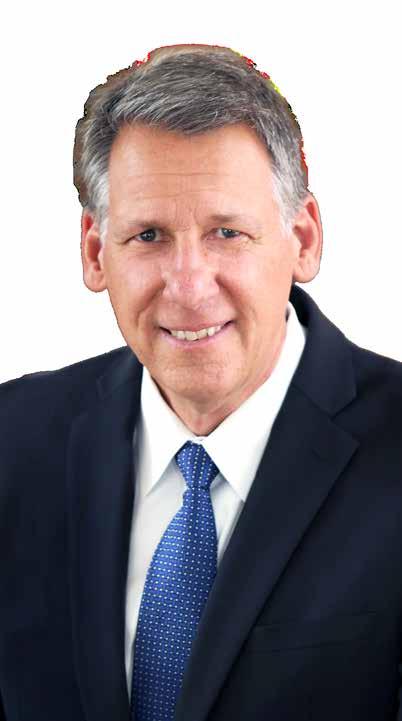
Thank you for lighting the way for education, leadership and success in our industry.
Greg,
Greg Siegel Illuminators 2023-2024 Headlite

GREG SIEGEL BRINGS SERIOUS ENERGY AND GOOD FUN TO THE ILLUMINATORS
Headlite’s long-standing commitment benefits group’s members, grocery industry
To understand what makes Greg Siegel a fearless leader look no further than how he has fun—jumping out of planes with his 80-year-old father and trekking up his eleventh peak to 14,000 feet with his daughter.
Siegel, who serves as the 94th HeadIite and President of The lluminators, has approached his leadership role with the same kind of intrepid confidence and calm—all while having a blast.
By Dorsey Griffith

Siegel dove straight into his year-long tenure as The Illuminators Headlite back in May 2023 and hasn’t lost momentum, filling his calendar with travel, board meetings and events. He jokes that he’s on the road for The Illuminators far more often than for his sales job, especially compared to the
COVID-19 pandemic period, when every work-related meeting moved to Zoom. His trajectory to become Headlight was a given after 10 years of service with the organization beginning as a member, then serving on the board for three years as a Hilite, then one year each as Tailite, Spotlite, Sidelite.
“We were motivated by going to the conventions and listening to the speakers,” he said in a call from his home office in Denver. “We thought it would be good for our company to be involved in the organization. We get a lot of exposure with our customers—we can work directly with retailers.”
Siegel’s dad, two brothers, and brother-in-law skydiving in Eloy, Arizona for their Dad’s 80th birthday.
| CALIFORNIA GROCER 36
Siegel with Illuminator Officer Team: Sideline Subriana Pierce, Spotlite Lori Brown and Tailite Tommy Huls.
It turns out that the long hours Siegel has given to The Illuminators have paid off for the company he’s worked for the past 10 years, Idahoan Foods, a 60-year-old instant potato product business based in Idaho Falls.
Asked about the products he represents, Siegel beams with pride.
“We dehydrate over 100 million pounds of potatoes annually, which starts with a half billion pounds of potatoes,” he said, adding that Idahoan Foods enjoys over 80% of the market share with products available at almost every grocery store in the country. As regional sales director, Siegel is responsible for a vast region spanning Texas west to Hawaii.
A potato fan, Siegel stated that they are an excellent source of carbohydrates and can sustain life, as they did in the fictitious movie “The Martian” starring Matt Damon.
Siegel said he is honored to serve his products at CGA and Western Association of Food Chains (WAFC) events—along with many other Illuminator members whose companies donate food, snacks, and beverages for convention attendees.
As Headlite, Siegel understands how essential The Illuminators are to the California Grocers Association—and the broader grocery industry. The organization’s nearly 350 vendor members are the backbone of the annual WAFC convention, for example, dishing up their traditional hospitality by greeting, meeting and serving 1,800 conventiongoers.
They also support the California Grocers Association Strategic Conference in Palm Springs in September, as well as its Torch Award Dinner its Diversity, Equity & Inclusion events and the Winter Rallies.
“The level of energy and excitement of The Illuminators in supporting the CGA

conference is impressive and sustained each year,” he said. “Every CGA conference is different, and our team of committee members evolves and delivers every time.”
Siegel is especially impressed with how creative members of The Illuminators are. “There is input and growth from every area and each committee that keep our organization fresh and relevant,” he said. “Many of these ideas come from our new members who have new perspectives, which is essential to that growth.”
Partnership, one of the three pillars of The Illuminators, is also a personal priority for Siegel—a commitment that is not lost on Dennis Darling, whose term as chair of the board of the CGA ended in September 2023.
“He’s a really kind man, and is totally committed to the industry,” Darling said. “His leadership is a big personal and business commitment in terms of time and resources. He’s willing to do whatever he can to help with the organization, which helps the industry, too.”
Sometimes, that takes Siegel out of his comfort zone. As an example, Darling said neither he nor his friend are naturally comfortable addressing big crowds, but as leaders of the CGA and The Illuminators respectively they are nevertheless expected to be in the spotlight engaging and inspiring their organizations’ members.
Continued on page 38 ▶
CALIFORNIA GROCER | 37
Siegel with his wife Mary, daughter Allison and son Will.
◀ Continued from page 37
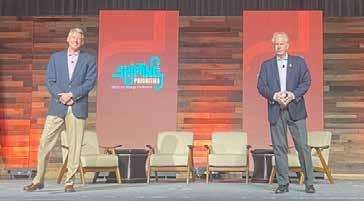
“One of the highlights for us is our presentation at the strategic conference in Palm Springs,” Darling said. “It’s a big event, and they expect us to talk about what is going on in the industry. It’s not something you do every day. We were both a little nervous about it.”
To ease nerves and lighten the mood, Darling quietly hatched a plan with Siegel. “It took a while, but I convinced him that when we were done with our serious talk, we should skip off the stage arm in arm,” he said. “He was up for it. At the end of our presentation, which Greg absolutely nailed, we joined arms, and we skipped off stage.”
The seemingly impromptu frivolity illustrated Siegel’s approach to the important business of grocery sales
and industry relations. Said Darling: “He takes his job seriously, but he’s going to have fun along the way. Greg has always got a smile on his face.”
Over the years, Siegel has become cheerleader-in-chief for the organization, constantly working to grow Illuminator membership and making sure everyone feels welcome.
“I help increase membership by talking about it all the time and asking our retailer partners to talk about the benefits of membership, as well. You really need to be involved so that everyone gets something out of it. You have to be there to see how the sausage is made, whether it’s showing up for the 5 a.m. breakfast committee meeting, being on the social media team or going to the golf tournament.”
Siegel has given equal attention to The Illuminators’ education and philanthropic programs. During his tenure, he and his leadership team brought together about 100 members to walk through Stater Bros. and Raley’s grocery stores in Southern California to better understand their objectives so they, in turn, can better serve the company with their
products and promotions. And he is proud that The Illuminators have been awarding more than $150,000 in needand merit-based educational scholarships for university, college and certificate programs for dependents of Illuminator and CGA members.
Asked about the people who have inspired him, Siegel need look no further than his own family. “My father, my brother, and every boss I’ve ever had,” he responds. His father, now 89, was a pharmaceutical company representative; both his brothers are also in sales.
“My older brother got out of college, got a job with Nestle with a good salary and a company car, which inspired me to do the same with Beecham products which is now Glaxo SmithKline. I thought, if he can do it, I can do it.”
Lucky for The Illuminators, CGA, and the WAFC, Siegel plans to keep on doing it— and supporting the organization he loves.
“When I’m done as the 94th Headlite in May, I will become the Dimmed Headlite,” he said. “I’ll then be an Advisor Officer for the next three years.” ■
 Siegel with daughter Allison at the top of Mt. Lincoln, one of the eleven 14,000 ft. peaks in Colorado they have climbed together.
Siegel with daughter Allison at the top of Mt. Lincoln, one of the eleven 14,000 ft. peaks in Colorado they have climbed together.
| CALIFORNIA GROCER 38
Siegel on stage at the 2023 CGA conference with Immediate Past Chair Dennis Darling.



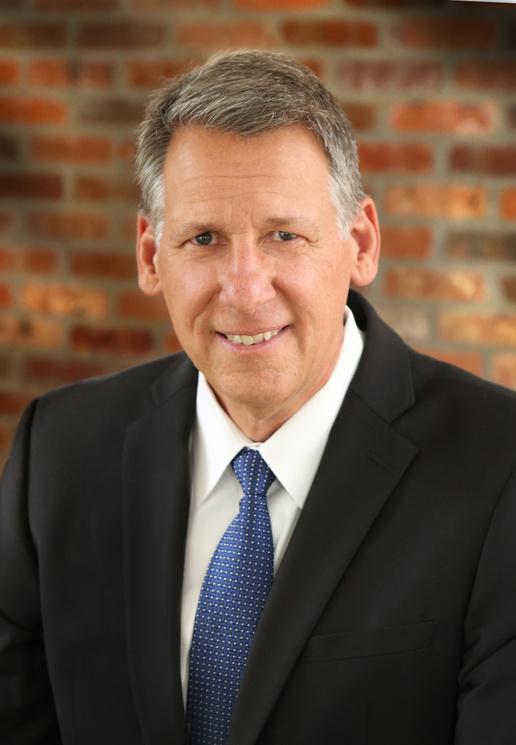
Greg Siegel
Headlite for his excellent leadership this past year
Illuminators thank CALIFORNIA GROCER | 39
2023-2024
The











AWARD-WINNING COMMERCIAL ARCHITECTURE FIRM RKAA.COM 2233 E THOMAS RD PHOENIX, AZ (602) 955-3900 1151 DOVE STREET, SUITE 175 NEWPORT BEACH, CA (949) 954-8785 • ADA Compliance Reviews • Exterior Facade Renovations • Lighting & Rebate Packages • Site Entitlement Processing • Prototypical Design Packages • Food Production Facilities • Online Ordering Design • Automated Distribution Centers • Restaurant / Kiosk Design mercatus.com/mercatus-mobile solutions@mercatus.com Learn more: Eoslift M25 Pallet Jack • Reliable & Efficient Manual Lift • Load Capacity 5,500 lbs. • Lifts 7+" for easy maneuvering • Has Added Controls, Push Rods 2-speed, Ergo handle & foot pedal
Backrest Option
•


(818) 817-6712 www.retailsolutionshq.com MAXIMIZE THE CART, REVOLUTIONIZE THE EXPERIENCE. Learn more about elevating the grocery customer experience with Digital Coupons and our Services! Coupon Redemption Digital Coupons Our products and services offer sustainability solutions.

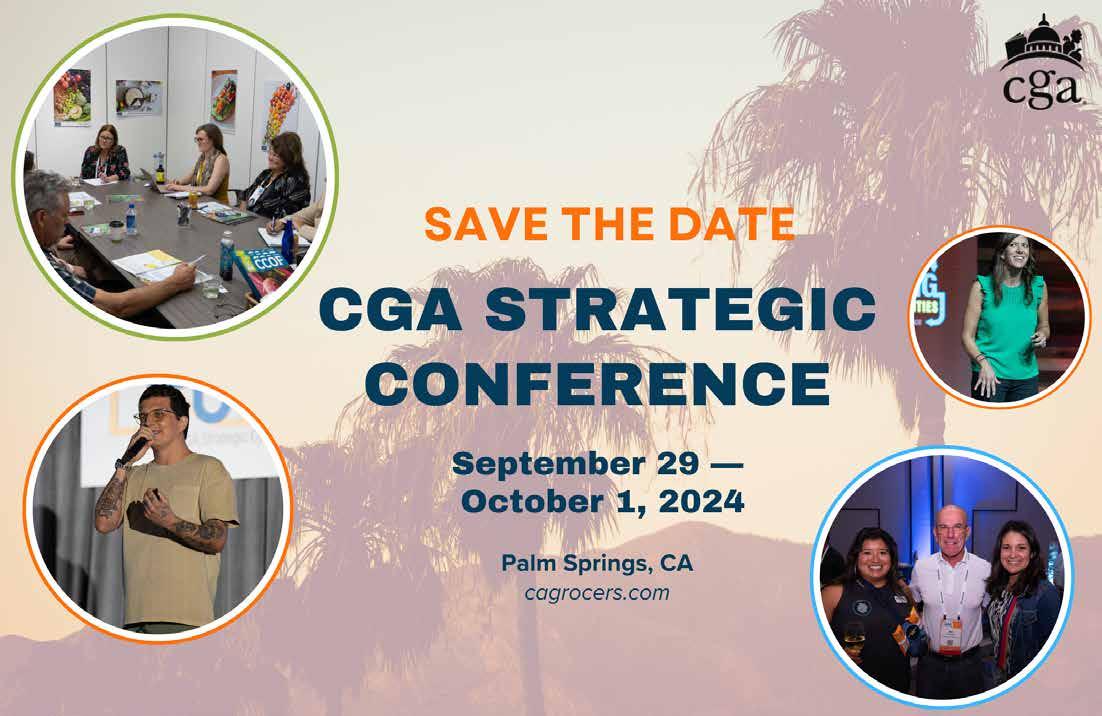
CALIFORNIA GROCER | 43
OUTSIDE THE BOX
NEW RETAIL PERSPECTIVES
BY GRACE BECKER
Social Commerce is taking off with TikTok Shop. Launched broadly last September in the U.S., TikTok Shop offers thousands of products across categories like makeup, clothing, food, and electronics. The platform allows TikTok creators to post videos featuring products and earn commissions, and supports live shopping. In Dan Frommer’s latest Consumer Trends Survey, among the people who said they used TikTok at least once per month, 69% said they were willing to buy something from TikTok, and 28% said they had already made a purchase. YipitData found that in November, people spent an estimated $363 million on TikTok Shop, up from $260 million in October.

https://shop.tiktok.com/business/us/newsroom/detail/10020329

DNA Diet
GenoPalate is taking the “food as medicine” movement to another level. In collaboration with health food market Earth Fare, GenoPalate is using DNA to determine diet. With its science-based approach, GenoPalate provides personalized dietary guidance based on your DNA to encourage choosing foods and meals that align with your genetic nutritional needs. Users either upload existing DNA data from sites like 23andMe or send in their data to receive a personalized Essential Nutrition Report that will inspire food purchases.

See You on the FlipSide
See You on the FlipSide

After years of users maintaining two Instagram accounts—one profile for public use, and a “finsta” account for close friends only, Instagram is finally catching on. Though the product is still a prototype, software engineer Alessandro Paluzzi shared internal screenshots of a new Instagram feature called “flipside” as a new online space just for friends. The feature would allow users to connect a secondary profile with its own avatar, name, and bio, that’s connected to the primary account. With flipside, users can share more personal posts with close friends without creating a second Instagram account.

!
| CALIFORNIA GROCER 44
Gift Mode Activated
To help its users perfect the art of gifting, Etsy launched Gift Mode to make it easier to narrow down the platform’s millions of items. When using Gift Mode, enter a few details about the person you’re shopping for and then they’ll be categorized with one of Etsy’s 200+ personas like The Music Lover, The Pet Parent, or The Host. Each persona comes with its own gift suggestions tailored to their interests. Because of Etsy’s broad scope of product offerings, Gift Mode is meant to help users parse through its offerings and differentiate the online marketplace from other e-commerce platforms like Amazon.

NOBuy
Fed up with overconsumption and inundated with targeted ads, a movement has picked up among certain TikTok users to encourage more thoughtful spending practices. A “no buy” is just what it sounds like—refraining from shopping for anything non-essential over a duration of your choosing. “No buy” participants can get specific about what they are or aren’t allowed to buy during their alotted period. The “no buy” is meant to encourage you to get more mileage out of the things you already own, curb impulse buying, and practice delayed gratification. Think of it as a cleanse from shopping.

Celeb Smoothies

In the latest iteration of its celebrity collaborations, Los Angeles luxury grocer Erewhon has released a smoothie with Sofie Richie Grainge. Content creator and daughter of Lionel Richie, Sofia joins peers including Kendall Jenner, Olivia Rodrigo, Gisel Bundchen, and Hailey Bieber who have all released their own personalized smoothies with the retailer. Coming in at $21, Sofia’s Sweet Cherry Smoothie centers her favorite superfood ingredients: dark sweet cherries and magnesium. A portion of the smoothie proceeds will go to Every Mothern Counts, which aims to provide equitable maternity care.
iStock
Photo: Etsy
OUTSIDE THE BOX CALIFORNIA GROCER | 45
CGA NEWS
INDEPENDENT OPERATORS SYMPOSIUM 2024
California’s independent grocery community kicked off 2024 on the Big Island of Hawaii for CGA’s annual Independent Operators Symposium. This immersive retreat allowed independent operators to step away from their family businesses to refocus and explore new opportunities for success.


In addition to relationship-building and taking time to recharge, our independent operators participated in inspiring educational sessions. President and CEO Ron Fong led attendees in the collaborative “Independent Exchange” share group discussion to tackle essential topics and challenges for family businesses; FMI President & CEO Leslie Sarasin walked a ttendees through FMI’s consumer trends report and sat down with Ron to discuss relevant developments in federal and state politics; Grocery veteran Steve Black revealed “The 5 Rules” for team transformation; and entertainer Sean Bott zeroed in on connection with top tips for attracting and retaining thriving talent.



Thank you to our independent operators for an energizing start to 2024!
Check out event photos below. ■


| CALIFORNIA GROCER 46
CGA ENDORSES REUSABLE PLASTIC BAG BAN BILL
During a press conference at the California State Capitol on February 8, 2024, the California Grocers Association announced its support of Sen. Catherine Blakespear’s (D-San Diego) and Asm. Rebecca Bauer-Kahan’s (D-Alameda) proposed bill banning the distribution of plastic film reusable bags for grocery retailers.
As consumer demand for sustainability evolves, CGA is helping guide this shift as a natural next step for grocery bags in California following the passage of SB 270 ten years ago, which eliminated single-use carryout bags. Without compromising convenience, this bill encourages a thoughtful approach to bags by prompting shoppers to bring reusable bags they already own from home. Consumers will still be able to purchase paper bags if they do not have a reusable bag.
“Beginning with the passage of SB 270 in 2014, California’s grocery industry has played a leading role in driving the state towards a common sense and responsible approach to the use of plastics and packaging by consumers,” said California Grocers Association VP of Government Relations, Daniel Conway. “We know that even the best policies may need to be updated over time to reflect changes in our society, so today marks the continuation of the work that started with SB 270 and is an important new chapter in our efforts to support the communities grocers serve and our environment.”
RON FONG NAMED A MOST ADMIRED CEO BY SACRAMENTO BUSINESS JOURNAL
President and CEO of California Grocers Association Ron Fong was named a “Most Admired CEO” for 2024 by Sacramento Business Journal. The award celebrates and recognizes local CEOs who have positively impacted their respective industries and contributed to the growth and success of Sacramento’s greater business community.
Honorees are selected by a peer group of CEOs, comprised of last year’s honorees, external nominations, and nominations by Sacramento Business Journal staff, that identifies influential local CEOs.
“Ron is a champion of the grocery industry in California and respected voice in the capitol community,” said CGA COO and Senior Vice President Doug Scholz. “This recognition from the Sacramento Business Journal is well deserved.”
The award comes as Ron begins his 16th year at the helm of CGA. During his tenure at CGA, Ron is credited with overhauling the government relations program, including the appointment of a
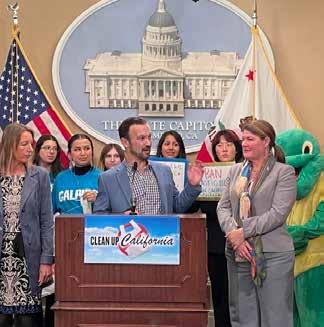
Effective January 1, 2026, the bill proposes that grocery stores may not provide a plastic film reusable grocery bag to consumers at the point of sale. To continue incentivizing waste reduction, grocers can offer non-plastic film reusable grocery bags or recycled paper bags to a consumer for no less than 10 cents at the point of sale. Reusable bags must meet certain requirements, like being made of washable material. Recycled paper bags are to be made available at no cost to WIC and SNAP customers.
“Consumers are calling for sustainable practices from California businesses, but still value a convenient shopping experience. This bill bridges the two to meet consumers where they are while demonstrating care for the environments in which our stores reside,” said CGA President and CEO Ron Fong. ■
new veteran lobbying and political team. In 2020, Governor Gavin Newsom appointed Ron to serve on his bi-partisan Task Force on Business and Jobs Recovery to help plan the state’s economic recovery following the financial calamity resulting from COVID-19. Ron also serves as President to the CGA Educational Foundation, which supports education opportunities for grocery industry workers, and oversees the Foundation’s expanding education, research, career development, and college scholarship programs.
Ron was honored alongside 20 other honorees at the Most Admired CEOs awards ceremony on March 7, 2024 in Sacramento. Honorees include: Kenn Altine, Sacramento SPCA; Derek Chase, OnSight Technology Inc.; Ethan Conrad, Ethan Conrad Properties; Brad DesJardin, DesCor Builders; Dawnté Early, United Way California Capital Region; Linda Farley, Girl Scouts Heart of Central California; Ronald Fong, California Grocers Association; Ginger Elizabeth Hahn, Ginger Elizabeth Chocolates; Lisa Hausmann, Mercy Hospital Folsom, Dignity Health; Preet Kuar, Pacific Staffing; Shobha Mallarapu, Anvaya Solutions Inc.; Heather Mauel, Dutch Bros Coffee Gold Country; Tony Moayed, Tricorp Group; Mymy Nguyen, Saigon Alley Kitchen & Bar; Michael Strech, North State Building Industry Association; Darrell Teat Jr., The Safety Center; Kim Tucker, Impact Foundry; Ali Wing, Oobli Inc.; and Rachel Zillner, Clutch. ■
CGA NEWS
CALIFORNIA GROCER | 47
SEC STORE TOUR: A BEHIND-THE-SCENES LOOK AT GELSON’S MARKETS IN WEST LA
On January 30, 2024, CGA’s Supplier Executive Council (SEC) had the privilege of gaining an exclusive look into the strategic vision behind the latest Gelson’s Markets location in West LA. Hosted by Gelson’s executives, such as John Bagan, Paul Kneeland, Tim Mahoney, and Rich Gillmore, this behind-the-scenes tour offered invaluable insights into the operations and innovation driving one of the region’s premier grocery chains. The tour offered participating grocery suppliers an inside view into the culinary innovation that Gelson’s is leaning on to set its new stores apart. From farm-fresh produce to gourmet prepared foods, attendees witnessed firsthand the dedication to quality and variety that defines the Gelson’s experience. Each department showcased meticulous attention to detail and a commitment to sourcing the finest ingredients.
A heartfelt thank you goes out to our hosts John Bagan, Paul Kneeland, Tim Mahoney, and Rich Gillmore for graciously sharing their expertise and hospitality during the SEC tour. Their passion for excellence and dedication to enriching the grocery industry left a lasting impression on all attendees. ■
JOIN THE SEC
For those interested in joining the Supplier Executive Council and gaining access to exclusive events and networking opportunities like this, we encourage you to reach out to Sunny Porter at sporter@cagrocers.com. Membership in the SEC offers a unique chance to connect with industry leaders, stay abreast of the latest trends, and contribute to shaping the future of grocery retail.
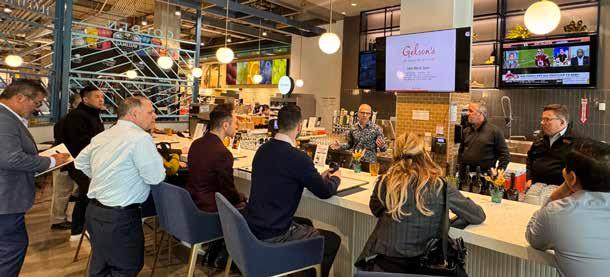


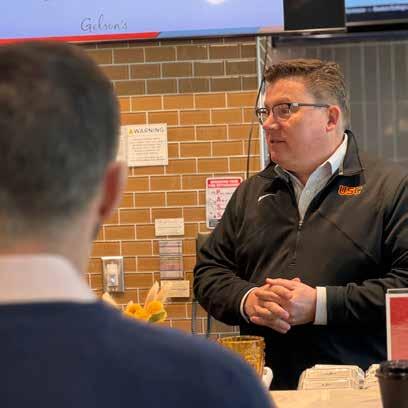
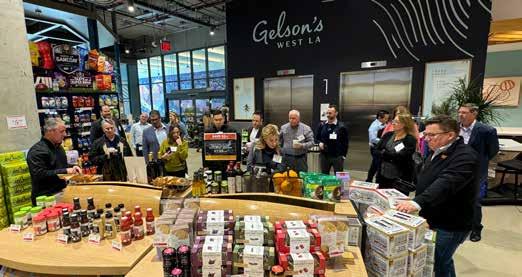
CGA NEWS | CALIFORNIA GROCER 48
NEW MEMBERS
CGA welcomes the following members:
CAM Services
21811 S Western Ave
Torrance, CA 90501-3724
Contact: Deborah Ansley Allen, Business Development Specialist
E-mail: aallen@camservices.com
Phone: (800) 576-3050
Website: camservices.com
Lowe Corporation
615 Hwy 74 S
Peachtree City, GA 30269
Contact: Kyle Payne, Head of Retail
E-mail: kyle.payne@lowerental.com
Phone: (770) 461-9001
Website: https://www.lowerental.com/us/ sectors/retail-services/

Pacific Coast Producers
631 N Cluff Ave
Lodi, CA 95240-0756
Contact: Andy Russick, VP, Sales & Marketing
E-mail: arussick@pcoastp.com
Phone: (209) 367-8800
Website: pacificcoastproducers.com

Tomato Products Wellness Council
2600 River Plaza Dr Ste 210
Sacramento, CA 95833
Contact: Alec Wasson, Executive Director
E-mail: aw@tomatowellness.com
Phone: (831) 234-3615
Website: tomatowellness.com

FaceFirst, Inc.
11801 Domain Blvd 3rd Floor
Austin, TX 78758-3429
Contact: Tim Elliott, Dir., Communications
E-mail: tim.elliott@facefirst.com
Phone: (818) 540-9800
Website: facefirst.com

Morenita Foods
935 Enterprise Way
Napa, CA 94558-6209
Contact: Jerry Curiel, Vice President
E-mail: jerry@morenitachips.com
Phone: (707) 328-3293
Website: morenitachips.com

Positive Beverage, LLC
2717 S Main St Ste B
Santa Ana, CA 92707-3434
Contact: Shannon Argyros, CEO
E-mail: shannon@positivebeverage.com
Phone: (941) 705-2876
Website: positivebeverage.com

Gaspar Insurance
23161 Ventura Blvd Ste 100
Woodland Hills, CA 91364
Contact: Nick Charton, Insurance Broker
E-mail: nick.charton@gasparinsurance.com
Phone: (818) 275-8458
Website: gasparinsurance.com/team/ nick-charton/

Oates Country Store
4819 Midway Rd
Vacaville, CA 95698
Contact: Randy Oates, Chief Financial Officer
Phone: (707) 446-7371
Surplus Asset Management Inc.
dba SAM Auctions
4111 W Claredon Ave
Phoenix, AZ 85019
Contact: John Lines, President
E-mail: jlines@surplusassetmanagement.com
Phone: (602) 442-4554
Website: samauctions.com

CGA NEW MEMBERS CALIFORNIA GROCER | 49

Consumers expect the best from their locally owned, independent supermarket and we at C&S fully understand and deliver on this expectation. By developing the necessary programs and offering the best possible product assortments, we help your store be the destination of choice in your neighborhood. Support at every level Contact us today to learn how we can help make this your best year ever! 1-800-446-0190 or visit www.cswg.com
Customized Grocery Workplace Harassment Prevention Training
All employees must be certified every two years
The California Grocers Association Educational Foundation provides online supervisor and employee training programs for workplace harassment prevention. These easy-to-use training modules are customized for the grocery industry and are fully compliant with California law.
CUSTOMIZED TRAINING FOR GROCERY INDUSTRY
• Real life in-store, office and warehouse scenarios
• Convenient one-hour employee course
• In-depth two-hour supervisor course
AFFORDABLE
• Substantial CGA member discounts
• Quantity pricing
• Flexible LMS hosting opportunities
EASY TO IMPLEMENT
• Tablet/desktop ready
• On-demand training for your employees
• Convenient reporting for compliance tracking & verification
English & Spanish Trainings Available
Purchase Today!
To learn more about these training modules including special CGA-member pricing, contact the CGA Educational Foundation at (916) 448-3545 or foundation@cagrocers.com.
CGA Educational Foundation | www.cgaef.org/training | (916) 448-3545
MOMMY BLOGGER
The Hunger Games
KIMBERLY RAE MILLER WRITER
Nurturing Healthy Habits One Aisle at a Time
My four-year-old daughter recently surprised me by declaring she has a “big belly,” unlike her friends in gymnastics class. To me, her belly seems perfectly normal, but when my kids express concerns about their bodies, I make sure to listen and address them. Being a mom to a little girl means navigating the pressures society puts on appearance from an early age. I thought this battle would come later, maybe in middle school, but life has its own timeline.
So, what’s the connection to grocery shopping? Well, everything, it turns out. Alongside reassuring my daughter that her body is beautiful, strong, and capable, I saw this as a golden opportunity to chat about the healthy foods she enjoys and how they fuel her amazing adventures. We also
had a candid chat about the not-so-healthy treats she loves and why they’re more of a sometimes snack than an all-the-time indulgence (even though they taste really, really good!).
Instead of my usual solo shopping trip, I took my daughter, Iris, along this time. Rather than sticking to our usual lunchbox staples, I let Iris pick out new foods she thought were healthy and energizing. With each choice, we chatted about protein, carbs, and vitamins and how they help her grow big and strong.
Raising healthy, happy kids truly takes a village, and where we shop plays a big role in that village. For grocers keen to be part of these life lessons, here are some ideas that also happen to build strong brand loyalty: Grocery Store Tours: Interactive tours can teach kids about food groups, reading labels, and making healthy choices. Highlighting specific healthy options and their benefits can make the trip even more enlightening.

Healthy Eating Workshops: Workshops with cooking demos, taste tests, and chats about balanced meals can engage both kids and parents.
Kids’ Cooking Classes: Classes for kids can teach them to whip up simple, healthy meals and snacks using fresh ingredients. Every mom knows that kids are far more likely to eat a healthy snack if they were the head chef involved in making it.
Nutrition Education Materials: Fun facts and tips about nutritious foods can be sprinkled throughout the store. Posters or pamphlets can make learning about healthy choices a breeze for kids and parents alike. In-Store Challenges or Games: Create games that encourage kids to explore different sections of the store and find healthy options. Think “scavenger hunts” for veggies or “treasure hunts” for whole grain snacks— complete with prizes to keep things exciting.
By incorporating these ideas, grocers can help shape healthy habits and create memorable experiences that keep families coming back for more. After all, healthy bodies and happy hearts start with our choices, one grocery trip at a time! ■
iStock | CALIFORNIA GROCER 52
The many impressive numbers behind Purina ONE
Adding
up the ways this cornerstone of the super premium category has spent a decade showing the power of science-backed nutrition on pet health.
By Joe Toscano, Vice President, Trade & Industry Development
They say numbers and data tell a story. So I’ll start with a noteworthy statistic. Roughly 40 percent of pet owners say they are willing to pay more for a pet food tailored to their pet’s needs. At this higher price point, pet owners want a food that does it all – a bowl that creates excitement at mealtime, not compromising on taste, but also has a positive impact on their pet’s health. That’s exactly why such outcomebased brands, like Purina ONE®, the largest pet food brand in the aisle, continue to drive tremendous growth in the super premium category.
For a brand that has become so synonymous with just a single number, Purina ONE has many digits worth celebrating, especially this year: 28. Making a pet food selection, especially a change, can be a stressful decision for any pet owner. That’s why Purina ONE has championed the 28-Day Challenge: just 28 days to see a difference in your pet. From a shiny coat to bright eyes and strong muscles, including a healthy heart, this time frame is all it takes for dog and cat owners to see the impact a science-backed nutrition formula can have on the life of their pet.
10. It’s been an incredible decade – 10 years – since the 28-Day Challenge was first introduced to consumers in 2014. And for this super premium brand, created around powerful ingredients found in nature, the results have been a consistent proof point of what you can achieve when you bring nature and research together.
61. To ensure the positive difference that begins on day one continues for a lifetime, there are 61 different formulas of ONE available for dog and cat owners, allowing a diet to be customized for the unique needs of each pet as they grow.
500. At Purina, we proudly have more than 500 scientists, veterinarians and nutritionists on staff, who work tirelessly to uncover breakthrough nutrition, like Purina ONE, that helps dogs and cats live longer, healthier lives. These experts fuel the innovation we believe should be pursued relentlessly, always focusing on the pet’s nutritional needs, safety and well-being. We apply our unrivaled scientific experience in
at Purina

A Difference From Day ONETM

pet nutrition, physiology and behavior to make new discoveries and push boundaries, creating real nutritional solutions for your shelves that can make a profound difference in the lives of pets.
2 million. Yes, million! Since its inception, nearly two million dog and cat consumers have registered to take the Purina ONE 28Day Challenge. We never tire of hearing the success stories of families who signed up and became loyal customers after seeing the positive, visible differences in their beloved family pets. In fact, many of these stories come from our retailer partners like you, and we love when you share them with your Purina sales representatives.
Zero. The number of ingredients in Purina ONE – and in any of our pet food brands –without a purpose. At Purina, we believe nutrition starts with understanding nutrients, not just ingredients. The best ingredients are the ones that work together to enhance one another’s performance. A smarter nutrient blend is more digestible and effective for a pet than a single ingredient. That’s why we don’t formulate our pet food on an ingredient basis but instead measure how different


formulations affect a pet’s overall health. Every ingredient in every Purina dog and cat food recipe was selected for a specific purpose, and with your pet’s health in mind. (You can visit purina.com/ingredients to see pictures and read ingredient descriptions and benefits of every ingredient in every Purina food.)
All these numbers are important, but at the end of the day (or at least at the end of this page), we know the most important numbers to you are how many consumers are returning to your store for their pet needs. Ensuring the right mix of science-backed, proven formulas on your shelves converts shoppers to loyal customers. Your Purina sales rep can provide you with additional information on the many formulas available that are tailored for the specific needs of your customers’ pets, including the exciting expansions coming to our Purina ONE line this year.
SUPPLIER PERSPECTIVES PET SPECIALTY
Purina trademarks are owned by Société des Produits Nestlé S.A.
California Grocer Online
Read California Grocer on your mobile device, or share with an associate. cagrocers.com





















PRSRT STD US Postage Paid Permit No. 1401 Sacramento, CA





















































 Siegel with daughter Allison at the top of Mt. Lincoln, one of the eleven 14,000 ft. peaks in Colorado they have climbed together.
Siegel with daughter Allison at the top of Mt. Lincoln, one of the eleven 14,000 ft. peaks in Colorado they have climbed together.






































































